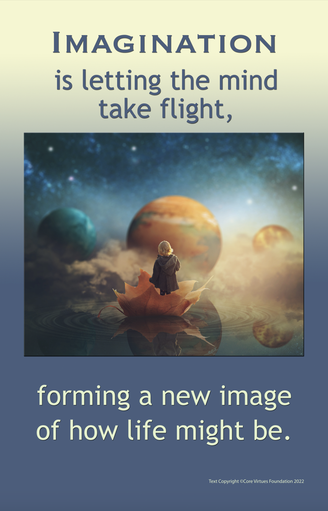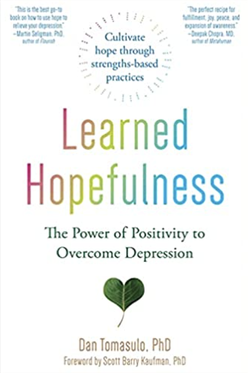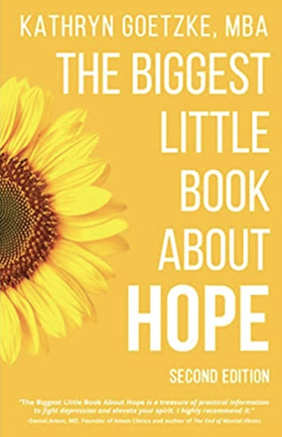We add books daily to our recommendations - visit us often!
To arrive in May—at long last May!—is to rejoice. May in the northern hemisphere has historically been a time for festivity associated with spring. May poles, May flowers, Mother's Day, and May crownings all speak to a tradition of new life and hope renewed. As spring asserts itself, we live in greater wonder at the world around us, and flights of fancy soar. Core Virtues celebrates that.
Year One leads with hope and joy because parents and educators—who are responsible for forming the next generation of citizens—have a special responsibility to nurture the hope of our children and feed their delight in the gift of life. A great deal in our culture and media conspires to turn children to cynicism and contempt. At Core Virtues we showcase the virtue that gives spring to our step, and acts as a catalyst for positive change and a brighter future. In the field of psychology a great deal of work has been done on the dimensions and importance of hope. Dr. Tomasulo's 2020 book, Learned Hopefulness (featured below) summarizes the research and pathways. If we teachers and parents are looking for other ways to enhance our own sense of hope and joy, read the reflections psychologist Benjamin Hardy here and for kids, check out Hopeful Minds Curriculum at https://hopefulminds.org.
New to our virtue roster in Year Two is "imagination." (We combined "hope" and "joy" into a single rubric for Year One.) Imagination ("letting the mind take flight, forming a new image of how life might be.") is a trait supportive of intellectual virtue. It is fueled by hope and accurately considered a virtue when in service of a better or brighter world. Our greatest writers, scientists, architects, and engineers have had extraordinary imaginations, which have helped us both better understand the world and better cope with it. Imagination may be more of a gift than a virtue, but in the early years of schooling, it is to be encouraged. Finally, in the third year of the rotation we turn to "wonder" as "the first step on the path to knowledge." This encourages us to marvel at the world around us, and sings to us in May.
Year One leads with hope and joy because parents and educators—who are responsible for forming the next generation of citizens—have a special responsibility to nurture the hope of our children and feed their delight in the gift of life. A great deal in our culture and media conspires to turn children to cynicism and contempt. At Core Virtues we showcase the virtue that gives spring to our step, and acts as a catalyst for positive change and a brighter future. In the field of psychology a great deal of work has been done on the dimensions and importance of hope. Dr. Tomasulo's 2020 book, Learned Hopefulness (featured below) summarizes the research and pathways. If we teachers and parents are looking for other ways to enhance our own sense of hope and joy, read the reflections psychologist Benjamin Hardy here and for kids, check out Hopeful Minds Curriculum at https://hopefulminds.org.
New to our virtue roster in Year Two is "imagination." (We combined "hope" and "joy" into a single rubric for Year One.) Imagination ("letting the mind take flight, forming a new image of how life might be.") is a trait supportive of intellectual virtue. It is fueled by hope and accurately considered a virtue when in service of a better or brighter world. Our greatest writers, scientists, architects, and engineers have had extraordinary imaginations, which have helped us both better understand the world and better cope with it. Imagination may be more of a gift than a virtue, but in the early years of schooling, it is to be encouraged. Finally, in the third year of the rotation we turn to "wonder" as "the first step on the path to knowledge." This encourages us to marvel at the world around us, and sings to us in May.
May Recommendations
The following books are a small sampling of the books recommended in the Resource Guide.
(grade levels indicated in parentheses)
Additional suggestions by virtue for K-3 ; Additional suggestions for 3-6
The following books are a small sampling of the books recommended in the Resource Guide.
(grade levels indicated in parentheses)
Additional suggestions by virtue for K-3 ; Additional suggestions for 3-6
New (to Us) and Noteworthy: Wonder of Reptiles!

Joan Procter, Dragon Doctor. Patricia Valdez. Illustrated by Felicita Sala. Knopf Books for Young Readers, 2018. (K-3) Wonder, Stewardship.
Vivid, artistic illustrations accompany the story of a very unusual life. Growing up in early 20th century London, young Joan was fascinated by reptiles—at age 16, she could be seen walking her pet crocodile down the street. When she grew up, she became the first female curator at the London Zoo’s Reptile House, and did important work introducing people to these often feared and misunderstood animals, particularly komodo dragons. Engagingly told.
Vivid, artistic illustrations accompany the story of a very unusual life. Growing up in early 20th century London, young Joan was fascinated by reptiles—at age 16, she could be seen walking her pet crocodile down the street. When she grew up, she became the first female curator at the London Zoo’s Reptile House, and did important work introducing people to these often feared and misunderstood animals, particularly komodo dragons. Engagingly told.

The Iguanodon's Horn: How Artists and Scientists Put a Dinosaur Back Together Again and Again and Again. Sean Rubin. Clarion Books, 2024. (1-4) Wonder, Diligence
Ever wonder how fossils go from finds to artistically fully fleshed forms? This intricate and richly illustrated book illuminates paleoart—how dinosaurs and other fauna and flora from paleolithic times may have looked. Rubin focuses on the changing ways Iguanadon was visualized over the years, and his detailed illustrations and historical sources enrich this story to appeal to dinosaur-loving adults and children alike. A powerful addition to the Core Knowledge 1st Grade Ice Age study or any unit on the scientific method. A triumph of wonder and diligence.
Ever wonder how fossils go from finds to artistically fully fleshed forms? This intricate and richly illustrated book illuminates paleoart—how dinosaurs and other fauna and flora from paleolithic times may have looked. Rubin focuses on the changing ways Iguanadon was visualized over the years, and his detailed illustrations and historical sources enrich this story to appeal to dinosaur-loving adults and children alike. A powerful addition to the Core Knowledge 1st Grade Ice Age study or any unit on the scientific method. A triumph of wonder and diligence.
New and Noteworthy for Parents and Teachers
|
Learned Hopefulness. Dan Tomasulo, Ph.D. New Harbinger Publications, 2020
Psychologist Dan Tomasulo employs the insights of positive psychology to explain what hope is, what it isn't (cheerful optimism), and how we can cultivate hopefulness to dramatically enhance the quality of our lives. Hopeful individuals see possibilities, notice beauty and benefits, and blessings, focus on strengths, cherish relationships, and create challenging goals. They have more energy and higher levels of happiness. Hope is the only virtue that requires adversity for its exercise. When dark times come, "high hope" individuals seek the possibilities. Dr. Tomasulo shows you how. |
|
The Biggest Little Book About Hope. Kathryn Goetzke. Innovative Analysis, 2020.
The founder of Hopeful Minds.org tells her compelling story here. After losing her father to suicide at age nineteen, she grappled with profound depression and sought a path forward. Her work in suicide prevention led to new and pathbreaking work on the cultivation of hope. In this 138 page volume, Goetzke presents the science and research on hopefulness, discusses key practices in the cultivation of hope (visualization, gratitude, journaling, forgiveness, etc.), speaks to obstacles, and then how to hone the tools that will help those at risk find their way from hopelessness to hope and happiness. |

There's No Place Like Hope. Janet Lawler. Illustrated by Tamisha Anthony. Farrar, Straus and Giroux, 2024. (K-2) Hope
This poem about hope will touch young children and adults alike—its simple message is accompanied by whimsical illustrations of children taking small risks, learning new things, and rejoicing with others. "There’s no place like hope, where possible lives, where people are helpful and everyone gives."
This poem about hope will touch young children and adults alike—its simple message is accompanied by whimsical illustrations of children taking small risks, learning new things, and rejoicing with others. "There’s no place like hope, where possible lives, where people are helpful and everyone gives."

Brave Baby Hummingbird. Sy Montgomery. Illustrated by Tiffany Bozic. Simon & Schuster, 2024. (K-3) Wonder, Courage
The story of a baby hummingbird's gradual growth, learning to take risks and develop into an adult. This book is a fun glimpse into the natural world as well as an inspiring example for younger kids of doing things even when they are a little scary, striking a good balance between natural science knowledge and first-person-narrator personality. A fascinating element of the book is how it depicts the hummingbirds being partly raised by a human being with lots of knowledge about hummingbird rescue—who turns out to be the author, a trained and licensed hummingbird rehabilitator. Stunning illustrations will reignite wonder at the beauty of nature.
The story of a baby hummingbird's gradual growth, learning to take risks and develop into an adult. This book is a fun glimpse into the natural world as well as an inspiring example for younger kids of doing things even when they are a little scary, striking a good balance between natural science knowledge and first-person-narrator personality. A fascinating element of the book is how it depicts the hummingbirds being partly raised by a human being with lots of knowledge about hummingbird rescue—who turns out to be the author, a trained and licensed hummingbird rehabilitator. Stunning illustrations will reignite wonder at the beauty of nature.

Gifts from Georgia's Garden: How Georgia O'Keeffe Nourished Her Art. Lisa Robinson. Illustrated by Hadley Hooper. Neal Porter Books, 2024 (K-2) Imagination, Lives to Learn From.
This book, with fittingly vibrant illustrations, tells the story of famous artist Georgia O'Keeffe with an emphasis on the elements of balance in her life: her enthusiasm for gardening and cooking as well as painting. Includes a recipe from O'Keeffe's own collection.
This book, with fittingly vibrant illustrations, tells the story of famous artist Georgia O'Keeffe with an emphasis on the elements of balance in her life: her enthusiasm for gardening and cooking as well as painting. Includes a recipe from O'Keeffe's own collection.

Wild Places: The Life of Naturalist David Attenborough. Hayley and John Rocco. Putnam, 2024 (K-2) Wonder, Stewardship, Lives to Learn From.
This lavishly-illustrated book tells the story of naturalist David Attenborough, from his childhood explorations in the woods to his later career forwarding the causes of environmental stewardship. Children will be inspired by Attenborough's adventurous life in jungles, oceans, mountains, and tundra. A fitting tribute to the best-known nature documentarian of our time.
This lavishly-illustrated book tells the story of naturalist David Attenborough, from his childhood explorations in the woods to his later career forwarding the causes of environmental stewardship. Children will be inspired by Attenborough's adventurous life in jungles, oceans, mountains, and tundra. A fitting tribute to the best-known nature documentarian of our time.

Bird Girl: Gene Stratton-Porter Shares Her Love of Nature with the World. Jill Esbaum and Rebecca Gibbon. Calkins Creek, 2024 (K-3) Wonder, Stewardship, Lives to Learn From.
Some teachers may know Gene Stratton-Porter best from her fiction and nonfiction books—notable among them A Girl of the Limberlost. Winsome, detailed illustrations help tell a simple yet remarkable story of a girl who loved and befriended birds, then grew up to be a photographer of remarkable birds as well as an author and naturalist whose home was full of birds. More detailed information on her life comes at the end of the book, sure to interest adults and older kids.
Some teachers may know Gene Stratton-Porter best from her fiction and nonfiction books—notable among them A Girl of the Limberlost. Winsome, detailed illustrations help tell a simple yet remarkable story of a girl who loved and befriended birds, then grew up to be a photographer of remarkable birds as well as an author and naturalist whose home was full of birds. More detailed information on her life comes at the end of the book, sure to interest adults and older kids.

Nacho's Nachos: The Story Behind the World's Favorite Snack. Sandra Nickel. Illustrated by Oliver Dominguez. Lee & Low Books, 2020. (K-3) Imagination.
A fun, true story about imagination that will intrigue younger and older readers alike. Young Ignacio Anaya, nicknamed "Nacho," like many people with the name Ignacio, lives in northern Mexico with his foster mother, who makes delicious quesadillas. Nacho grows up to work at a restaurant, where one day a customer asks for something new and special. Nacho, not really a cook himself, goes into the empty kitchen, draws on his childhood memories, and a world-famous snack is born. Includes, of course, a recipe for authentic nachos at the end, alongside a historical note.
A fun, true story about imagination that will intrigue younger and older readers alike. Young Ignacio Anaya, nicknamed "Nacho," like many people with the name Ignacio, lives in northern Mexico with his foster mother, who makes delicious quesadillas. Nacho grows up to work at a restaurant, where one day a customer asks for something new and special. Nacho, not really a cook himself, goes into the empty kitchen, draws on his childhood memories, and a world-famous snack is born. Includes, of course, a recipe for authentic nachos at the end, alongside a historical note.

The Polio Pioneer: Dr. Jonas Salk and the Polio Vaccine. Linda Elovitz Marshall. Illustrated by Lisa Anchin. Knopf Books for Young Readers, 2020. (K-3) Imagination, Hope
Jonas Salk grows up in a devout Jewish immigrant family, and notices things most other kids don’t—particularly, the needs of people in pain. The suffering of soldiers returning from World War I and the 1918 flu pandemic touched him. He resolved to be a doctor and researcher. His first remarkable work, being the co-inventor of the first flu vaccine, was followed by an even more important discovery: he invented the polio vaccine. Polio regularly killed and crippled thousands of people in the until the 1950s, and his work put an end to that. A colorfully-illustrated narrative that describes the history of the polio vaccine in enough detail to be interesting, but not so much that it will be bewildering to young readers.
Jonas Salk grows up in a devout Jewish immigrant family, and notices things most other kids don’t—particularly, the needs of people in pain. The suffering of soldiers returning from World War I and the 1918 flu pandemic touched him. He resolved to be a doctor and researcher. His first remarkable work, being the co-inventor of the first flu vaccine, was followed by an even more important discovery: he invented the polio vaccine. Polio regularly killed and crippled thousands of people in the until the 1950s, and his work put an end to that. A colorfully-illustrated narrative that describes the history of the polio vaccine in enough detail to be interesting, but not so much that it will be bewildering to young readers.

Dadaji's Paintbrush. Rashmi Sirdeshpande. Illustrated by Ruchi Mhasane. Levine Querido, 2022. Friendship, Hope, Love, Generosity. (K-3)
The bond of grandparent and grandchild is celebrated in this masterful work set in India. A young boy lives with his grandfather (Dadaji) and they love to paint together. Sometimes, other children come to learn how to paint from his grandfather. The boy and his Dadaji are supremely happy until, one day, the grandfather passes away. Grief-stricken, the boy puts his paintbrush away, and magical times disappear. One day a little girl knocks on his door and asks him to teach her to paint. Slowly, the boy comes back to life with the help of new friends and the understanding that his grandfather's love and gifts are still with him. With vivid details from the author's childhood time in Goa. Hope matters most in times of darkness.
The bond of grandparent and grandchild is celebrated in this masterful work set in India. A young boy lives with his grandfather (Dadaji) and they love to paint together. Sometimes, other children come to learn how to paint from his grandfather. The boy and his Dadaji are supremely happy until, one day, the grandfather passes away. Grief-stricken, the boy puts his paintbrush away, and magical times disappear. One day a little girl knocks on his door and asks him to teach her to paint. Slowly, the boy comes back to life with the help of new friends and the understanding that his grandfather's love and gifts are still with him. With vivid details from the author's childhood time in Goa. Hope matters most in times of darkness.

Mirandy and Brother Wind. Patricia McKissack. Illustrated by Jerry Pinkney. Dragonfly Books, 1997. (K-2) Wonder, Friendship.
Young Mirandy is going to the junior cakewalk jubilee, and she has the perfect partner in mind: the mysterious Brother Wind. So she sets out on a journey to capture the wind, with family and friends offering advice, strategies, or skepticism along the way. Eventually, she triumphs, but to her own surprise, she finds that her friend Ezel is the person she really wants to dance with. Illustrated fancifully by the master Jerry Pinkney.
Young Mirandy is going to the junior cakewalk jubilee, and she has the perfect partner in mind: the mysterious Brother Wind. So she sets out on a journey to capture the wind, with family and friends offering advice, strategies, or skepticism along the way. Eventually, she triumphs, but to her own surprise, she finds that her friend Ezel is the person she really wants to dance with. Illustrated fancifully by the master Jerry Pinkney.
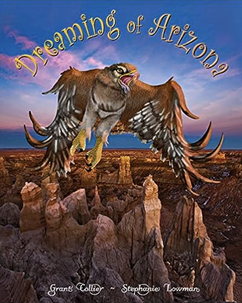
Dreaming of Arizona. Grant Collier. Illustrated by Stephanie Lowman. Collier Publishing, 2021. K-3 Wonder, Love of Country
Set in the Grand Canyon, Harlow, a curious owl, overflies a world of extraordinary natural beauty. Then he falls asleep and beholds his world through the passage of time. Extraordinary paintings show the Grand Canyon from its Ice Age beginnings with mastodons, giant sloths, "Arizonasaurus," giant cats, and antelope, through to Native American settlers with their "hogans" and hardy pioneers on their canoes. An exhausted Harlow returns to the nest content and ready to explore more of the southwest. Works well with any Ice Age unit. (This is one of several "Dreaming of" books about the American southwest.)
Set in the Grand Canyon, Harlow, a curious owl, overflies a world of extraordinary natural beauty. Then he falls asleep and beholds his world through the passage of time. Extraordinary paintings show the Grand Canyon from its Ice Age beginnings with mastodons, giant sloths, "Arizonasaurus," giant cats, and antelope, through to Native American settlers with their "hogans" and hardy pioneers on their canoes. An exhausted Harlow returns to the nest content and ready to explore more of the southwest. Works well with any Ice Age unit. (This is one of several "Dreaming of" books about the American southwest.)
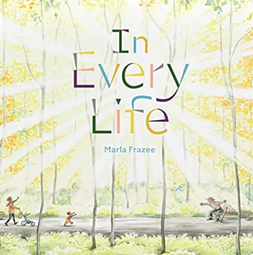
In Every Life. Marla Frazee. Beach Lane Books, 2023. Gratitude, Wonder, Hope, Joy, Schools of Faith. (K-1)
Inspired by a traditional Jewish baby-naming blessing, this simple book is a sweetly-illustrated and wondrous tour through the beautiful moments of being human. From the happy to the sad to the poignant, illustrations of people of all ages and all races experiencing moments of life accompany beautiful phrases that will stick with the reader long after the book is closed—"In every moment, blessed is the mystery. In every sadness, blessed is the comfort. In every love, blessed are the tears." This is a book for very young children, but even adults will take something meaningful from it.
Inspired by a traditional Jewish baby-naming blessing, this simple book is a sweetly-illustrated and wondrous tour through the beautiful moments of being human. From the happy to the sad to the poignant, illustrations of people of all ages and all races experiencing moments of life accompany beautiful phrases that will stick with the reader long after the book is closed—"In every moment, blessed is the mystery. In every sadness, blessed is the comfort. In every love, blessed are the tears." This is a book for very young children, but even adults will take something meaningful from it.
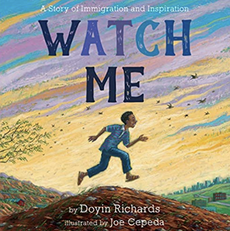
Watch Me: A Story of Immigration and Inspiration. Doyin Richards. Illustrated by Joe Cepeda. Feiwel & Friends, 2021. Perseverance, Hope, Lives to Learn From (K-3)
Based on the true story of Dr. Joe Richards, an immigrant from Sierra Leone, who as a child leaves behind refugee camps in his war-torn land to come to a country where he was not always welcomed with open arms. His skin was dark and at times he confronted racism, intolerance, and bullying. But that wasn't the whole story, and he didn't let it define him. Joe wanted to be a doctor and made "Watch me; I will succeed, I will do great things," his creed. He did become a physician and his son says that his life was one of "choosing hope over fear, confidence over self-doubt and kindness over indifference." Dr. Joe's empathy and hope will inspire little children (and their teachers/parents).
Based on the true story of Dr. Joe Richards, an immigrant from Sierra Leone, who as a child leaves behind refugee camps in his war-torn land to come to a country where he was not always welcomed with open arms. His skin was dark and at times he confronted racism, intolerance, and bullying. But that wasn't the whole story, and he didn't let it define him. Joe wanted to be a doctor and made "Watch me; I will succeed, I will do great things," his creed. He did become a physician and his son says that his life was one of "choosing hope over fear, confidence over self-doubt and kindness over indifference." Dr. Joe's empathy and hope will inspire little children (and their teachers/parents).
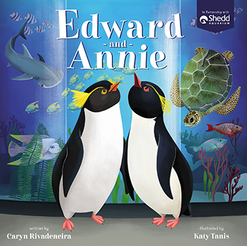
Edward and Annie: A Penguin Adventure. Caryn Rivadeneira. Illustrated by Katy Tanis. Thomas Nelson, 2022. (K-2) Wonder
A funny and uplifting true story. Just when you thought the pandemic made everything grim, consider Edward and Annie, two rockhopper penguins at the Shedd Aquarium in Chicago, who (among others) are set free by their trainers to explore their own Aquarium after hours (with no people inside). They marvel at beluga whales, who marvel back! (These creatures never meet in the wild since they live in different hemispheres.) Many other encounters affirm not just animal curiosity/wonder at their surroundings, but that the world is a big and amazing place.
A funny and uplifting true story. Just when you thought the pandemic made everything grim, consider Edward and Annie, two rockhopper penguins at the Shedd Aquarium in Chicago, who (among others) are set free by their trainers to explore their own Aquarium after hours (with no people inside). They marvel at beluga whales, who marvel back! (These creatures never meet in the wild since they live in different hemispheres.) Many other encounters affirm not just animal curiosity/wonder at their surroundings, but that the world is a big and amazing place.
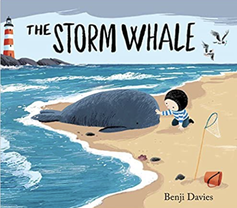
The Storm Whale. Benji Davies.
Simon and Schuster, 2013. K-1 Wonder, Compassion, Friendship, Responsibility.
Little Noi lives a lonely life on an island. While his hardworking father fishes by day, the boy has six cats for company, but when a baby whale washes ashore after a storm, Noi is thrilled with a new friend. And he's eager to help the little whale recover. It's hard to keep him a secret in the bathtub though… Noi's dad has a better idea. A great (if not realistic) story about the responsibility to help a creature in need, the beauty and wonder of the sea, and compassion for the vulnerable. Noi's friendship with the whale and his friendship with his father make this a warm and delightful read. (This is one of three charming Storm Whale books.)
Simon and Schuster, 2013. K-1 Wonder, Compassion, Friendship, Responsibility.
Little Noi lives a lonely life on an island. While his hardworking father fishes by day, the boy has six cats for company, but when a baby whale washes ashore after a storm, Noi is thrilled with a new friend. And he's eager to help the little whale recover. It's hard to keep him a secret in the bathtub though… Noi's dad has a better idea. A great (if not realistic) story about the responsibility to help a creature in need, the beauty and wonder of the sea, and compassion for the vulnerable. Noi's friendship with the whale and his friendship with his father make this a warm and delightful read. (This is one of three charming Storm Whale books.)
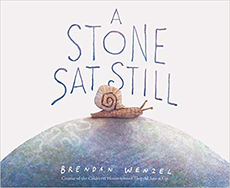
A Stone Sat Still. Brendan Wenzel.
Chronicle Books, 2019. (K-1) Wonder, Wisdom
This deceptively simple, and supremely lyrical picture book is, as the title suggests, about one stone, immobile but not immutable. The stone changes its qualities, depending on the perspective of those who visit and surround it. It is a bright, moonlit resting place for an owl; a dark, sheltering stump for a mouse, a tiny pebble for a moose, a great hill to a bug, a silent witness for some, or a loud echo for the clam shell tossed by the gull. Yet all the time, "It was as it was where it was in the world." Illustrations soft, pale, but striking show how one inanimate presence could be so many different things to so many. Beauty of nature abounds but also an excellent springboard for K-1 discussions about perspective, empathy, and the changing ways we see.
Chronicle Books, 2019. (K-1) Wonder, Wisdom
This deceptively simple, and supremely lyrical picture book is, as the title suggests, about one stone, immobile but not immutable. The stone changes its qualities, depending on the perspective of those who visit and surround it. It is a bright, moonlit resting place for an owl; a dark, sheltering stump for a mouse, a tiny pebble for a moose, a great hill to a bug, a silent witness for some, or a loud echo for the clam shell tossed by the gull. Yet all the time, "It was as it was where it was in the world." Illustrations soft, pale, but striking show how one inanimate presence could be so many different things to so many. Beauty of nature abounds but also an excellent springboard for K-1 discussions about perspective, empathy, and the changing ways we see.
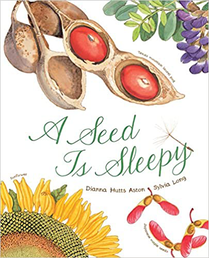
A Seed is Sleepy. Dianna Aston. Illustrated by Sylvia Long. Chronicle Books, 2007 (K-3) Wonder
Poetic text and exquisite watercolors magnify seeds of every shape and size, making this gift of nature a source of wonder. “A seed is adventurous. It must strike out on its own in search of a less crowded place to put down roots.” This is one of a truly "wonder-ful" series of science/wonder books by Aston and Long, each as beautiful as the first. (A Nest is Noisy, An Egg is Quiet, A Butterfly is Patient, A Rock is Lively)
Poetic text and exquisite watercolors magnify seeds of every shape and size, making this gift of nature a source of wonder. “A seed is adventurous. It must strike out on its own in search of a less crowded place to put down roots.” This is one of a truly "wonder-ful" series of science/wonder books by Aston and Long, each as beautiful as the first. (A Nest is Noisy, An Egg is Quiet, A Butterfly is Patient, A Rock is Lively)
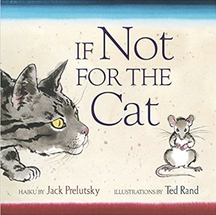
If Not For the Cat. Jack Prelutsky. Illustrated by Ted Rand.
Greenwillow Books, 2004. (K-3) Poetry, Wonder
A book of seventeen haiku poems exploring the animal kingdom. Exquisitely spare verse gives clues to the unnamed animals on each page ("If not for the cat/And the scarcity of cheese,/ I could be content"), but a “Who is Who” page allows you to confirm your guesses! The language is mellifluous, illustrations are a delight, and the natural world never seemed so wondrous.
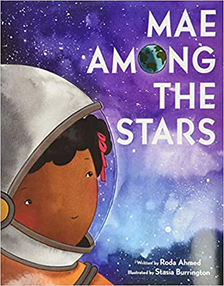
Mae Among the Stars. Roda Ahmed. Illustrated by Stasia Burrington. Harper Collins, 2018. (K-3) Imagination, Perseverance, Lives to Learn From, Black History Month
The inspirational story of the first African-American woman in space. Mae Jemison dreamed of her life among the stars since childhood: dancing among them, floating and gliding by them, looking down at Earth. She shared her dream of becoming an astronaut with her parents, friends and teachers--some of whom urged her to keep her feet on the ground! They tried to dissuade her. But Mae, "the dreamer," worked hard towards her goal, kept dreaming big, and realized her goal. Energetic artwork portrays Mae’s dream beautifully.
The inspirational story of the first African-American woman in space. Mae Jemison dreamed of her life among the stars since childhood: dancing among them, floating and gliding by them, looking down at Earth. She shared her dream of becoming an astronaut with her parents, friends and teachers--some of whom urged her to keep her feet on the ground! They tried to dissuade her. But Mae, "the dreamer," worked hard towards her goal, kept dreaming big, and realized her goal. Energetic artwork portrays Mae’s dream beautifully.

My Dear Noel: The Story of a Letter from Beatrix Potter. Jane Johnson.
Dial Books, 1999. (K-2) Imagination
Beatrix Potter always knew how to delight children and make the world seem a marvelous place. But she did not begin to write her Peter Rabbit tales until a friend, a six-year-old boy, became ill and had to be in bed all summer. In this true story, Noel Moore receives a great gift from a good friend: the first story of Peter Rabbit. Her story renews his spirits and delights us with a world of naughty rabbits that drink chamomile tea.
Dial Books, 1999. (K-2) Imagination
Beatrix Potter always knew how to delight children and make the world seem a marvelous place. But she did not begin to write her Peter Rabbit tales until a friend, a six-year-old boy, became ill and had to be in bed all summer. In this true story, Noel Moore receives a great gift from a good friend: the first story of Peter Rabbit. Her story renews his spirits and delights us with a world of naughty rabbits that drink chamomile tea.
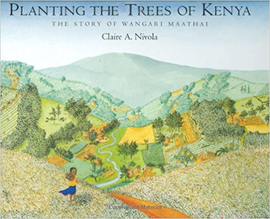
Planting the Trees of Kenya: The Story of Wangari Maathai.
Claire Nivola. Frances Foster Books, 2008. (K-3)
Stewardship, Hope, Lives to Learn From
A beautifully illustrated and inspiring biography of 2004 Nobel Prize winner Wangari Maathai, who led Kenya’s “Green Belt” movement. Born and raised in the hills of central Kenya, Wangari treasured the richness and beauty of her land. She went off to study biology in the United States (in 1960) and seven years later returned to her homeland to find it largely deforested. Maathai led a movement of Kenyan women to replant trees and restore not simply the stripped land, but the relationship between the land and its people. She was fabulously successful, and was awarded the Nobel Prize for her efforts. This is a stunning book about a woman determined to make the world better place – one tree and one woman at a time.
Claire Nivola. Frances Foster Books, 2008. (K-3)
Stewardship, Hope, Lives to Learn From
A beautifully illustrated and inspiring biography of 2004 Nobel Prize winner Wangari Maathai, who led Kenya’s “Green Belt” movement. Born and raised in the hills of central Kenya, Wangari treasured the richness and beauty of her land. She went off to study biology in the United States (in 1960) and seven years later returned to her homeland to find it largely deforested. Maathai led a movement of Kenyan women to replant trees and restore not simply the stripped land, but the relationship between the land and its people. She was fabulously successful, and was awarded the Nobel Prize for her efforts. This is a stunning book about a woman determined to make the world better place – one tree and one woman at a time.

The Watcher. Jane Goodall’s Life With the Chimps. Jeanette Winter. Schwartz Wade Books, 2011. (K-3) Lives to Learn From, Diligence, Stewardship, Hope, Joy
A simple biography of Jane Goodall’s amazing life with her beloved chimps. A quiet and keen observer from an early age, Jane loved animals and knew that she wanted to study them in the wild. She worked hard to make that happen, eventually moving from London to the Gombe forest in Tanzania to study chimpanzees. The chimps became accustomed to "the white ape" among them (the phrase is Jane's self-description). Goodall spent many years studying the primates, writing about them, and educating the world about their habits. When deforestation threatened the forests in which they lived, Jane realized she could be a voice for the chimps. At age 85, she continues to educate many about protecting animals, their habitat, and the planet.
A simple biography of Jane Goodall’s amazing life with her beloved chimps. A quiet and keen observer from an early age, Jane loved animals and knew that she wanted to study them in the wild. She worked hard to make that happen, eventually moving from London to the Gombe forest in Tanzania to study chimpanzees. The chimps became accustomed to "the white ape" among them (the phrase is Jane's self-description). Goodall spent many years studying the primates, writing about them, and educating the world about their habits. When deforestation threatened the forests in which they lived, Jane realized she could be a voice for the chimps. At age 85, she continues to educate many about protecting animals, their habitat, and the planet.
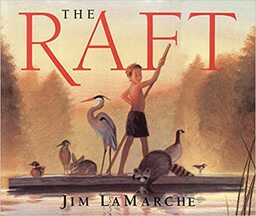
The Raft. Jim LaMarche. Harper Collins, 2002. (K-3)Wonder, Joy
When Nicky has to spend the summer with his grandmother in the woods of Wisconsin, he is sure it will be the worst summer ever. But one day he finds a raft floating down the river. It makes his chores (fishing for their dinner) fun and brings him to a new relationship with his grandmother. She shares his adventures and her love of drawing. Beautiful pastels illustrate and illuminate this charming story.
When Nicky has to spend the summer with his grandmother in the woods of Wisconsin, he is sure it will be the worst summer ever. But one day he finds a raft floating down the river. It makes his chores (fishing for their dinner) fun and brings him to a new relationship with his grandmother. She shares his adventures and her love of drawing. Beautiful pastels illustrate and illuminate this charming story.
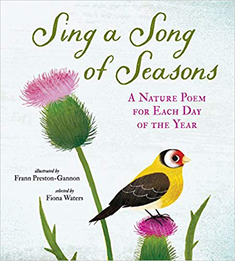
Sing A Song of Seasons: A Nature Poem for Each Day of the Year.
Fiona Waters, editor, Illustrated by Frann Preston-Gannon.
Nosy Crow, 2018, (K-6) Wonder, Joy
This gorgeous, hefty volume is a great way for teachers and parents to infuse poetry into everyday life. Fun and lively illustrations are the backdrop for relatively short, seasonally appropriate poems for every day of the year. (Great for memorizing.) Old favorites, new poems, serious and silly: each inspires wonder and delight at the beauty of nature. A poetry anthology, rather than a Morning Gathering read-aloud, and a treasure for the classroom or for family to share.
Fiona Waters, editor, Illustrated by Frann Preston-Gannon.
Nosy Crow, 2018, (K-6) Wonder, Joy
This gorgeous, hefty volume is a great way for teachers and parents to infuse poetry into everyday life. Fun and lively illustrations are the backdrop for relatively short, seasonally appropriate poems for every day of the year. (Great for memorizing.) Old favorites, new poems, serious and silly: each inspires wonder and delight at the beauty of nature. A poetry anthology, rather than a Morning Gathering read-aloud, and a treasure for the classroom or for family to share.
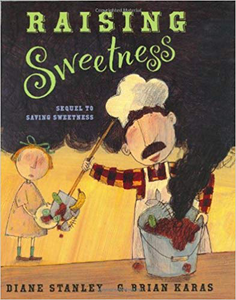
Stanley, Diane. Saving Sweetness and Raising Sweetness.
Illustrated by G. Brian Karas. Putnam’s, 1996, 1998 (K-3)Hope
These two books are a big departure from Diane Stanley’s serious work on such major figures as Queen Elizabeth, Leonardo Da Vinci, and others. But they are a delight and a Texas hoot! In the first book a kind-hearted, but slow-witted Texas sheriff rescues spunky “little Sweetness” and six other orphans from the evil Mrs. Sump’s orphanage. In the second volume he sets about raising them with determination, but minimal domestic skills. His charges decide he could use a wife, and set about making sure he finds one. Of course, they succeed. With its Texas idiom and Stanley’s humor, this is laugh-out loud funny. OK, maybe we’re just recommending it cuz it’s so funny. But good humor and happy endings give us all hope!
Illustrated by G. Brian Karas. Putnam’s, 1996, 1998 (K-3)Hope
These two books are a big departure from Diane Stanley’s serious work on such major figures as Queen Elizabeth, Leonardo Da Vinci, and others. But they are a delight and a Texas hoot! In the first book a kind-hearted, but slow-witted Texas sheriff rescues spunky “little Sweetness” and six other orphans from the evil Mrs. Sump’s orphanage. In the second volume he sets about raising them with determination, but minimal domestic skills. His charges decide he could use a wife, and set about making sure he finds one. Of course, they succeed. With its Texas idiom and Stanley’s humor, this is laugh-out loud funny. OK, maybe we’re just recommending it cuz it’s so funny. But good humor and happy endings give us all hope!

The Library. Sarah Stewart. Illustrated by David Small. Farrar, Straus, Giroux, 1997. (K-3) Wisdom, Wonder, Generosity.
Whimsical and buoyant verse delight the young reader. Elizabeth Brown is a bibliophile through and through -- from her youth to her old age, when her impressive book collection becomes a library for others. If the following lines sing to you, delight your students too. "She didn't like to play with dolls. She didn't like to skate. She learned to read quite early. And at an incredible rate." In clever verse and illustration, the author tells the story of Elizabeth Brown's life and fortune. A story that will feed the soul of any young bibliophile.
Whimsical and buoyant verse delight the young reader. Elizabeth Brown is a bibliophile through and through -- from her youth to her old age, when her impressive book collection becomes a library for others. If the following lines sing to you, delight your students too. "She didn't like to play with dolls. She didn't like to skate. She learned to read quite early. And at an incredible rate." In clever verse and illustration, the author tells the story of Elizabeth Brown's life and fortune. A story that will feed the soul of any young bibliophile.
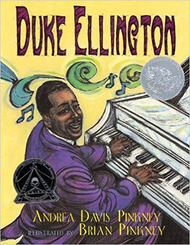
Duke Ellington: The Piano Prince and His Orchestra. Andrea Davis Pinkney, .
Illustrated by Brian Pinkney. Paw Prints, 2007. (K-3) Hope
The joy and hope of Duke Ellington’s life and music are wonderfully accessible to little ones in this picture book. The Pinkneys follow Ellington from his childhood in Washington, D.C. to his swinging Harlem Cotton Club debut. Their union of text and painting—the text is sassy and the paintings vividly joyful—capture his creativity and the novelty of his work in improvisational music.
Illustrated by Brian Pinkney. Paw Prints, 2007. (K-3) Hope
The joy and hope of Duke Ellington’s life and music are wonderfully accessible to little ones in this picture book. The Pinkneys follow Ellington from his childhood in Washington, D.C. to his swinging Harlem Cotton Club debut. Their union of text and painting—the text is sassy and the paintings vividly joyful—capture his creativity and the novelty of his work in improvisational music.
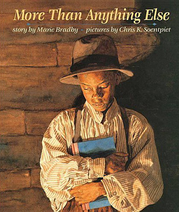
More Than Anything Else. Marie Bradby.
Illustrated by Chris K. Soentpiet. Orchard Books, 1995. (K-2) Hope
Young Booker T. Washington toils in the salt works with his father and brothers, but longs for the day when he’ll learn to read. He has a “hunger . . . in my head” and “even though my shoulders still ache and my legs are stained with salt, I . . . stare at the marks and try to imagine their song.” This is a beautifully and warmly illustrated story of a young boy whose hope is realized.
Illustrated by Chris K. Soentpiet. Orchard Books, 1995. (K-2) Hope
Young Booker T. Washington toils in the salt works with his father and brothers, but longs for the day when he’ll learn to read. He has a “hunger . . . in my head” and “even though my shoulders still ache and my legs are stained with salt, I . . . stare at the marks and try to imagine their song.” This is a beautifully and warmly illustrated story of a young boy whose hope is realized.
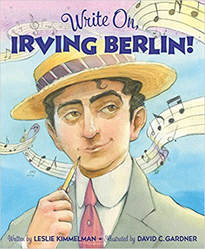
Write On, Irving Berlin! * Leslie Kimmelman.
Illustrated by David C. Gardner. Sleeping Bear Press, 2018. (K-3)
Lives to Learn From, Hope & Joy, Love of Country
The inspirational story of the self-taught musical genius, who became America’s most iconic songwriter. Fleeing persecution in Russia in 1893, five-year-old Israel Baline emigrated to the United States with his family of eight. The Balines lived in a small New York City apartment, lacking money and sometimes food, but they had their freedom and their wits. And little Izzy always seemed to have a song in his heart. He began singing in saloons, writing songs, and signing himself Irving Berlin at age thirteen—and the rest is history. (He sold his first song for 37 cents.) Write On is a whimsically illustrated picture book that captures Berlin’s drive, optimism, passion for music (he wrote songs on his shirt sleeves, in elevators, in the bathtub), and his unabashed love of country (which he served overseas in World War I). “Alexander’s Ragtime Band,” “God Bless America,” “Always,” and “White Christmas” are just a few of his hits for stage, screen, and troops overseas. *Available on Epic!
Illustrated by David C. Gardner. Sleeping Bear Press, 2018. (K-3)
Lives to Learn From, Hope & Joy, Love of Country
The inspirational story of the self-taught musical genius, who became America’s most iconic songwriter. Fleeing persecution in Russia in 1893, five-year-old Israel Baline emigrated to the United States with his family of eight. The Balines lived in a small New York City apartment, lacking money and sometimes food, but they had their freedom and their wits. And little Izzy always seemed to have a song in his heart. He began singing in saloons, writing songs, and signing himself Irving Berlin at age thirteen—and the rest is history. (He sold his first song for 37 cents.) Write On is a whimsically illustrated picture book that captures Berlin’s drive, optimism, passion for music (he wrote songs on his shirt sleeves, in elevators, in the bathtub), and his unabashed love of country (which he served overseas in World War I). “Alexander’s Ragtime Band,” “God Bless America,” “Always,” and “White Christmas” are just a few of his hits for stage, screen, and troops overseas. *Available on Epic!

Miss Rumphius. Barbara Cooney. Puffin, 1985. (K-2)
Stewardship, Wonder
Residing on a seaside cliff, elderly Miss Rumphius is something of a enigma to neighborhood children. When they visit, they hear her story of a life well lived, and of a woman intent on giving something back to the world. The mystery and beauty of life are joined with determination to do one’s part. Miss Rumphius’ lupines are living proof of her love.
Stewardship, Wonder
Residing on a seaside cliff, elderly Miss Rumphius is something of a enigma to neighborhood children. When they visit, they hear her story of a life well lived, and of a woman intent on giving something back to the world. The mystery and beauty of life are joined with determination to do one’s part. Miss Rumphius’ lupines are living proof of her love.
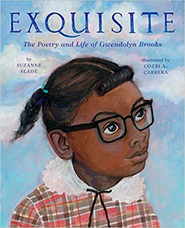
Exquisite. The Poetry and Life of Gwendolyn Brooks. Suzanne Slade. Illustrated by Cozbi A. Cabrera. Abrams for Young Readers, 2020. (1-4) Lives to Learn From, Wonder, Perseverance, Black History Month.
Born in 1917, she dared to dream. The first Black author to win the Pulitzer Prize, Chicago-born Gwendolyn Brooks grew up in a family that prized the written word, and she began to write poetry at age seven. She wrote with grace and beauty about poverty, race, gender, nature and loneliness. We meet Brooks in this lyrical work; she lived through the Great Depression and saw ways to make it sing in words. Named Poet Laureate of Illinois in 1958, Brooks will inspire young readers to make poetry of their lives.
Born in 1917, she dared to dream. The first Black author to win the Pulitzer Prize, Chicago-born Gwendolyn Brooks grew up in a family that prized the written word, and she began to write poetry at age seven. She wrote with grace and beauty about poverty, race, gender, nature and loneliness. We meet Brooks in this lyrical work; she lived through the Great Depression and saw ways to make it sing in words. Named Poet Laureate of Illinois in 1958, Brooks will inspire young readers to make poetry of their lives.
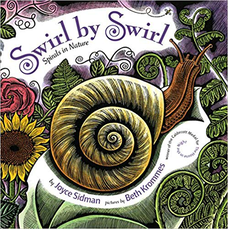
Swirl by Swirl. Spirals in Nature. Joyce Sidman. Illustrated by Beth Krommes. Houghton Mifflin, 2011. (K-1) Wonder
Striking and vibrant illustrations practically leap off the page, as we explore spiral shapes in nature, and how those fabulous swirls in plants, shells, animals, water, and galaxies protect and preserve life. The spare text is just enough to enhance understanding of the illustrations, and make kids marvel at nature's grandeur. If "wonder" is the "first step on the path to knowledge," this book is truly wonder-full.
Striking and vibrant illustrations practically leap off the page, as we explore spiral shapes in nature, and how those fabulous swirls in plants, shells, animals, water, and galaxies protect and preserve life. The spare text is just enough to enhance understanding of the illustrations, and make kids marvel at nature's grandeur. If "wonder" is the "first step on the path to knowledge," this book is truly wonder-full.
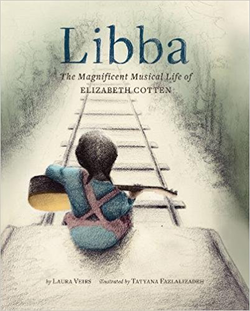
Libba: The Magnificent Musical Life of Elizabeth Cotton. Laura Veirs. Illustrated by Tatyana Fazlalizadeh. Chronicle Books, 2018. (K-4) Imagination, Diligence
As an African-American child in the early 1900s, Elizabeth Cotton heard music on the wind, in the woods, and on the train tracks. She taught herself to play her brother’s guitar, and that was tricky because she was left-handed and he was not. She learned to play it upside down and backwards, wrote the song “Freight Train” by the time she was eleven, and developed a repertoire. A career in music wasn’t an option for girls of her background, though. So for years, Libba worked as a maid and housekeeper, became a mother and grandmother, and kept the music in her heart – till she started to work for the Seeger family (of folk music fame). This a lyrically written and softly illustrated book that speaks to all who have a passion they do not abandon – and especially to late bloomers.
As an African-American child in the early 1900s, Elizabeth Cotton heard music on the wind, in the woods, and on the train tracks. She taught herself to play her brother’s guitar, and that was tricky because she was left-handed and he was not. She learned to play it upside down and backwards, wrote the song “Freight Train” by the time she was eleven, and developed a repertoire. A career in music wasn’t an option for girls of her background, though. So for years, Libba worked as a maid and housekeeper, became a mother and grandmother, and kept the music in her heart – till she started to work for the Seeger family (of folk music fame). This a lyrically written and softly illustrated book that speaks to all who have a passion they do not abandon – and especially to late bloomers.
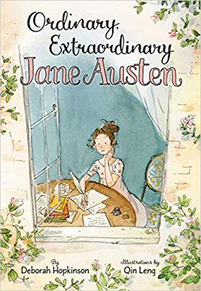
Ordinary, Extraordinary Jane Austen. Deborah Hopkinson.
Illustrated by Qin Leng. Balzer and Bray, 2018. (K-3)
Imagination, Wonder, Lives to Learn From
Long before children will read the great writer, they can learn an important lesson from her: pay attention to your childhood! In this engaging biography, Hopkinson takes us back to Jane Austen’s youth, growing up in a lively home with one sister, six “boisterous brothers plus packs of boys who came to live and study at their father’s boarding school,” scads of books, and a vivid imagination. Jane is observant, attentive to the personalities and quirks of each of the characters in her midst, and in her writing about the ordinary, conveys the extraordinary. Leng’s soft watercolor illustrations glow and bring the period to life.
Illustrated by Qin Leng. Balzer and Bray, 2018. (K-3)
Imagination, Wonder, Lives to Learn From
Long before children will read the great writer, they can learn an important lesson from her: pay attention to your childhood! In this engaging biography, Hopkinson takes us back to Jane Austen’s youth, growing up in a lively home with one sister, six “boisterous brothers plus packs of boys who came to live and study at their father’s boarding school,” scads of books, and a vivid imagination. Jane is observant, attentive to the personalities and quirks of each of the characters in her midst, and in her writing about the ordinary, conveys the extraordinary. Leng’s soft watercolor illustrations glow and bring the period to life.
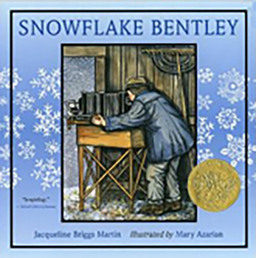
Snowflake Bentley. Jacqueline Briggs Martin. Illustrated by Mary Azarian. Houghton Mifflin, 2009. (K-3) Imagination, Courage
A beautifully illustrated, true story of intellectual courage. Vermont farm boy, Wilson Bentley, never lost his life-long fascination with snowflakes. He was captivated by their beauty as a child, puzzled over them, and at age 17 (in 1882) began photographing the six-pointed flakes, finding no one flake identical to another. His passion for this wonder of nature and patience in mastering its photography, rewarded each of us with a fuller understanding of snowflake structure, recognized only late in his life. Bentley received little reward along the way. Ultimately, this is a book about intellectual courage and the perseverance needed to pursue one's ideas.
A beautifully illustrated, true story of intellectual courage. Vermont farm boy, Wilson Bentley, never lost his life-long fascination with snowflakes. He was captivated by their beauty as a child, puzzled over them, and at age 17 (in 1882) began photographing the six-pointed flakes, finding no one flake identical to another. His passion for this wonder of nature and patience in mastering its photography, rewarded each of us with a fuller understanding of snowflake structure, recognized only late in his life. Bentley received little reward along the way. Ultimately, this is a book about intellectual courage and the perseverance needed to pursue one's ideas.
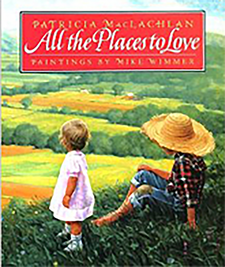
All the Places to Love. Patricia MacLachlan. Illustrated by Mike Wimmer. Harper Collins, 1994. (K-2) Hope & Joy, Wonder
On the day he was born, grandpa cried and grandma held Eli up to the window “so that what I heard first was the wind. What I saw first were all the places to love: the valley, the river falling down over rocks, the hilltop where the blueberries grew.” Try not to cry as you follow Eli and his family through meadows, hayfields, rocks and rivers, as he learns about all the places to love and imagines sharing them with his newborn sister. Themes of wonder, hope, and family devotion.
On the day he was born, grandpa cried and grandma held Eli up to the window “so that what I heard first was the wind. What I saw first were all the places to love: the valley, the river falling down over rocks, the hilltop where the blueberries grew.” Try not to cry as you follow Eli and his family through meadows, hayfields, rocks and rivers, as he learns about all the places to love and imagines sharing them with his newborn sister. Themes of wonder, hope, and family devotion.
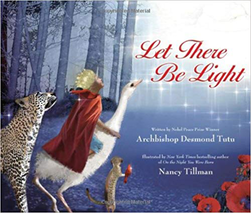
Let There Be Light. Archbishop Desmond Tutu. Illustrated by Nancy Tillman. Zonderkidz, 2014. (K-3) Wonder, Schools of Faith
Beautiful retelling of the creation story. Nancy Tillman’s digital illustrations lend a great deal to the beauty and wonder of the story.
Beautiful retelling of the creation story. Nancy Tillman’s digital illustrations lend a great deal to the beauty and wonder of the story.
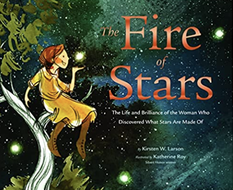
The Fire of Stars: The Life and Brilliance of the Woman Who Discovered What Stars Are Made Of. By Kirsten W. Larson. Chronicle Books, 2023. (K-3) Women's History Month, Wonder, Perseverance.
The whimsically-illustrated story of astronomer and astrophysicist Cecilia Payne is lyrically told, and tells the story of her life in parallel with a scientific narrative about the birth of a star. Before Payne, no one knew exactly what stars were made of, what gas burns at the heart of stars. Despite the fact that women astronomers were rare at the time of her work (she made her great discovery at age 25 in 1925), she diligently stuck to her work and made great strides. Bonus material at the end tells more of Payne's story and narrates the birth of a star in panels. (Catholic schools may wish to be aware that one spread portrays Payne's experience with religious sisters at a school in a negative light.)
The whimsically-illustrated story of astronomer and astrophysicist Cecilia Payne is lyrically told, and tells the story of her life in parallel with a scientific narrative about the birth of a star. Before Payne, no one knew exactly what stars were made of, what gas burns at the heart of stars. Despite the fact that women astronomers were rare at the time of her work (she made her great discovery at age 25 in 1925), she diligently stuck to her work and made great strides. Bonus material at the end tells more of Payne's story and narrates the birth of a star in panels. (Catholic schools may wish to be aware that one spread portrays Payne's experience with religious sisters at a school in a negative light.)
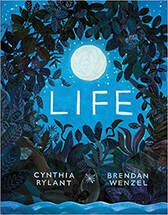
Life by Cynthia Rylant. Illustrated by Brendan Wenzel.
Beach Lane Books, 2017 (K-3) Wonder, Stewardship
This meditative reflection on life in the world encourages children to think beyond themselves. Beautiful illustrations transport us from Africa to the Arctic and everywhere in between. “life begins small…then it grows” is a reassuring thought for a small child. There is comfort in knowing that change is coming and even if there are some hard times, they can trust nature and find beauty everywhere
Beach Lane Books, 2017 (K-3) Wonder, Stewardship
This meditative reflection on life in the world encourages children to think beyond themselves. Beautiful illustrations transport us from Africa to the Arctic and everywhere in between. “life begins small…then it grows” is a reassuring thought for a small child. There is comfort in knowing that change is coming and even if there are some hard times, they can trust nature and find beauty everywhere
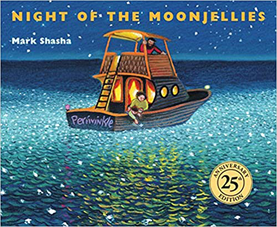
Night of the Moonjellies. Mark Shasha. Purple House Press, 2017. (K-4) Diligence, Responsibility, Wonder.
Combining family, responsibility, hard work, and the beauty of the New England shore, this is the story of a devoted seven-year-old boy who spends two weeks each summer helping his grandmother run her seaside hot dog stand. After a day of labor, Gram has a surprise. The intrepid pair set off at night in her motor boat to see a spectacle of nature: luminescent moon jellies, tiny shimmering creatures that bespangle the sea in late summer. Joy, wonder, and love suffuse the pages.
Combining family, responsibility, hard work, and the beauty of the New England shore, this is the story of a devoted seven-year-old boy who spends two weeks each summer helping his grandmother run her seaside hot dog stand. After a day of labor, Gram has a surprise. The intrepid pair set off at night in her motor boat to see a spectacle of nature: luminescent moon jellies, tiny shimmering creatures that bespangle the sea in late summer. Joy, wonder, and love suffuse the pages.

Flat Stanley: His Original Adventure.* Jeff Brown.
Illustrated by Macky Pamintuan. Harper Collins, 2013. (1-5) Humor, Wonder
When a bulletin board falls on Stanley one night, he wakes up flat. Flat – as in only half-an-inch thick. Life as a pancake doesn’t stop Stanley from enjoying himself and having adventures. This is a fun early chapter book for beginning readers, which encourages kids to think about the wonder of being themselves. What things can they enjoy because of who and how they are? There are many additional books in the series. *Available on Epic!
Illustrated by Macky Pamintuan. Harper Collins, 2013. (1-5) Humor, Wonder
When a bulletin board falls on Stanley one night, he wakes up flat. Flat – as in only half-an-inch thick. Life as a pancake doesn’t stop Stanley from enjoying himself and having adventures. This is a fun early chapter book for beginning readers, which encourages kids to think about the wonder of being themselves. What things can they enjoy because of who and how they are? There are many additional books in the series. *Available on Epic!
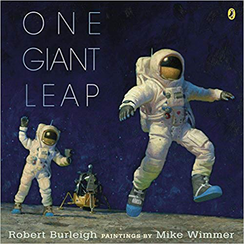
One Giant Leap. Robert Burleigh. Illustrated by Mike Wimmer.
Puffin, 2014 (K-4) Hope & Joy, Wonder, Love of Country
Burleigh captures the suspense, excitement, and nail-biting quality of the extraordinary flight of Apollo 11. Children will identify with Neil Armstrong and Buzz Aldrin, who set off to explore a world that human beings had dreamt of visiting for centuries. “One small step for a man; one giant leap for mankind.” This is a marvelous book with spectacular, slightly surreal illustrations that put one in mind of 2001: A Space Odyssey.
Puffin, 2014 (K-4) Hope & Joy, Wonder, Love of Country
Burleigh captures the suspense, excitement, and nail-biting quality of the extraordinary flight of Apollo 11. Children will identify with Neil Armstrong and Buzz Aldrin, who set off to explore a world that human beings had dreamt of visiting for centuries. “One small step for a man; one giant leap for mankind.” This is a marvelous book with spectacular, slightly surreal illustrations that put one in mind of 2001: A Space Odyssey.

Queen of Physics: How Wu Chien Shiung Helped Unlock the Secrets of the Atom. Teresa Robeson. Illustrated by Rebecca Huang. Union Square Kids, 2019. (1-3) Diligence, Wonder, Perseverance, Courage, Women's History Month
Wu Chien Shiung was born in China in 1912 to an unusual family: parents who believed that girls had the same right to learn as boys, and who started a school to teach girls. The daughter's name meant “courageous hero.” And she indeed grew up to do great things, eventually traveling to Berkeley, California to do groundbreaking work in nuclear physics. As a woman of Asian descent in the 1930s, Wu Chien had an uphill battle in her field, but was undeterred. Geared to younger kids, this book does a good job of explaining Wu’s work in a way that everyone can understand, but the subject material and glossary at the end ensure that adults and older kids will also learn a lot from this book.
Wu Chien Shiung was born in China in 1912 to an unusual family: parents who believed that girls had the same right to learn as boys, and who started a school to teach girls. The daughter's name meant “courageous hero.” And she indeed grew up to do great things, eventually traveling to Berkeley, California to do groundbreaking work in nuclear physics. As a woman of Asian descent in the 1930s, Wu Chien had an uphill battle in her field, but was undeterred. Geared to younger kids, this book does a good job of explaining Wu’s work in a way that everyone can understand, but the subject material and glossary at the end ensure that adults and older kids will also learn a lot from this book.

The Oldest Student: How Mary Walker Learned to Read. Rita Lorraine Hubbard. Illustrated by Oge Mora. (1-4) Perseverance, Patience, Diligence, Courage, Hope, Women's History Month.
Cutout-style illustrations from Caldecott-winning Oge Mora accompany this tale of Mary Walker, born into slavery in 1848, who learned to read in 1963—at the age of 116. A striking story about the power of perseverance against all odds and the extraordinarily long life of a woman who saw both the Civil War and the Civil Rights Movement. An inspiring and humbling story that will help both children and adults put their own difficulties into perspective—and remind children who may be struggling to read that there is always plenty of time.
Cutout-style illustrations from Caldecott-winning Oge Mora accompany this tale of Mary Walker, born into slavery in 1848, who learned to read in 1963—at the age of 116. A striking story about the power of perseverance against all odds and the extraordinarily long life of a woman who saw both the Civil War and the Civil Rights Movement. An inspiring and humbling story that will help both children and adults put their own difficulties into perspective—and remind children who may be struggling to read that there is always plenty of time.
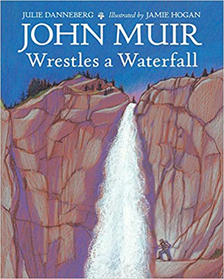
John Muir Wrestles a Waterfall.* Julia Danneber. Illustrated by Jamie Hogan. Charlesbridge, 2015. (1-4) Wonder, Lives to Learn From
This glimpse at naturalist John Muir’s life in Yosemite centers on his fascination with the giant waterfall there. He built his cabin in sight of the fall, and studied it from all angles ("cascading, crashing, careening wildly over the side of the mountain."). One night he was drawn to climbing the rock face next to the water. Suddenly the wind lifted the wall of water away from the rocks and John was able to slip behind the wall of water! Oh exhilaration! Until… the wind ceased, and the water poured down on top of him. Fortunately, he survived to tell the tale and continued to study and record the sites and sounds of Yosemite. Beautifully drawn pastels along with handwritten journal pages make this an exciting and interesting read. Scottish-born Muir was America's first and premier conservationist, seeing the divine in the majesty of nature. *Available on Epic!
This glimpse at naturalist John Muir’s life in Yosemite centers on his fascination with the giant waterfall there. He built his cabin in sight of the fall, and studied it from all angles ("cascading, crashing, careening wildly over the side of the mountain."). One night he was drawn to climbing the rock face next to the water. Suddenly the wind lifted the wall of water away from the rocks and John was able to slip behind the wall of water! Oh exhilaration! Until… the wind ceased, and the water poured down on top of him. Fortunately, he survived to tell the tale and continued to study and record the sites and sounds of Yosemite. Beautifully drawn pastels along with handwritten journal pages make this an exciting and interesting read. Scottish-born Muir was America's first and premier conservationist, seeing the divine in the majesty of nature. *Available on Epic!
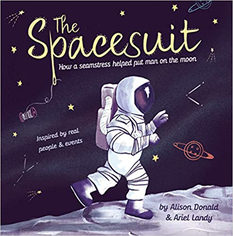
The Spacesuit. *Alison Donald & Ariel Landy. Maverick Arts, 2019. (K-2) Imagination, Diligence,Wonder *on Epic!
Did you know there was a contest to design the spacesuits worn by our astronauts on the moon? A team of engineers worked with a team of seamstresses to make a suit that would keep the astronauts safe in space. This is the true story of Ellie Foraker, who "helped change the world with a needle and thread many years ago." As the head seamstress of a team, she faced design challenges with clever ideas. Her skill and dedication made their team's spacesuit the winner. A great recognition that sewing, a historically female excellence, can really matter!
Did you know there was a contest to design the spacesuits worn by our astronauts on the moon? A team of engineers worked with a team of seamstresses to make a suit that would keep the astronauts safe in space. This is the true story of Ellie Foraker, who "helped change the world with a needle and thread many years ago." As the head seamstress of a team, she faced design challenges with clever ideas. Her skill and dedication made their team's spacesuit the winner. A great recognition that sewing, a historically female excellence, can really matter!
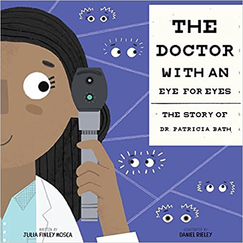
The Doctor with an Eye for Eyes Julia Finley Mosca. Illustrated by Daniel Rieley. Innovation Press, 2017, (K-3) Perseverance, Diligence
Told in playful, sing-song rhyme, this is the story of Dr. Patricia Bath born in Harlem (1942) and intrigued by nature early on. She received a life-changing chemistry set from her parents, who told her "never settle for less than your best." She overcame poverty, racism and sexism to become an eye doctor, and became the inventor of laser cataract surgery, which gave sight to many world wide.
Told in playful, sing-song rhyme, this is the story of Dr. Patricia Bath born in Harlem (1942) and intrigued by nature early on. She received a life-changing chemistry set from her parents, who told her "never settle for less than your best." She overcame poverty, racism and sexism to become an eye doctor, and became the inventor of laser cataract surgery, which gave sight to many world wide.
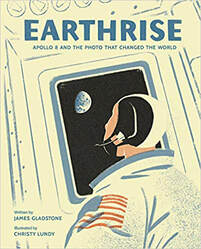
Earthrise: Apollo 8 and the Photo that Changed the World. *
James Gladstone. Illustrated by Christy Lundy. Owlkids Books, 2018
(K-3) Wonder, Gratitude, Stewardship
Kids raised in a digital age can scarcely conceive of a time when we did not know what our planet looked like from space. The Apollo 8 lunar mission (1969) was a milestone, and this first picture of the earth rising above the surface of the moon struck a chord worldwide. People were inspired to see the world without borders; struck by its beauty, they launched a new movement to care for the earth. An important moment to remember even 50 years later. *Available on Epic!
James Gladstone. Illustrated by Christy Lundy. Owlkids Books, 2018
(K-3) Wonder, Gratitude, Stewardship
Kids raised in a digital age can scarcely conceive of a time when we did not know what our planet looked like from space. The Apollo 8 lunar mission (1969) was a milestone, and this first picture of the earth rising above the surface of the moon struck a chord worldwide. People were inspired to see the world without borders; struck by its beauty, they launched a new movement to care for the earth. An important moment to remember even 50 years later. *Available on Epic!
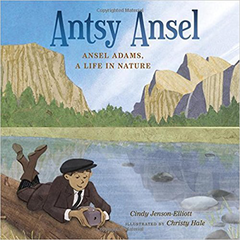
Antsy Ansel: Ansel Adams, A Life in Nature. Cindy Jenson-Elliott. Illustrated by Christy Hale. Henry Holt, 2016. (K-4)Hope & Joy, Wonder
American photographer Ansel Adams often captured the stillness and awe-inspiring majesty of nature, but his own nature was far from tranquil. This lyrical text chronicles the childhood of a boy who could not sit still. He sought out the gusts of the sea, the pound of the surf, the rush of water through canyons, and the glow of light on craggy peaks. He was “on fire for learning,” but his father realized that traditional schooling was not for Ansel; he needed to be outside. Jenson-Elliott captures the young boy’s exuberance, his wonder at all of nature (so evident in his photographs of the Sierra Nevadas, Yosemite, the Tetons). Christy Hale complements the text with her clean, striking, collage illustrations, including two vertical spreads mimicking Ansel’s Yosemite heights photos. An excellent introduction to the trail-blazing photographer, whose “awe before the unexplained” suffuses every photo. (The book will also reassure any child who has a hard time sitting still, and just might encourage restless kids to seek out the wonders of nature.)
American photographer Ansel Adams often captured the stillness and awe-inspiring majesty of nature, but his own nature was far from tranquil. This lyrical text chronicles the childhood of a boy who could not sit still. He sought out the gusts of the sea, the pound of the surf, the rush of water through canyons, and the glow of light on craggy peaks. He was “on fire for learning,” but his father realized that traditional schooling was not for Ansel; he needed to be outside. Jenson-Elliott captures the young boy’s exuberance, his wonder at all of nature (so evident in his photographs of the Sierra Nevadas, Yosemite, the Tetons). Christy Hale complements the text with her clean, striking, collage illustrations, including two vertical spreads mimicking Ansel’s Yosemite heights photos. An excellent introduction to the trail-blazing photographer, whose “awe before the unexplained” suffuses every photo. (The book will also reassure any child who has a hard time sitting still, and just might encourage restless kids to seek out the wonders of nature.)
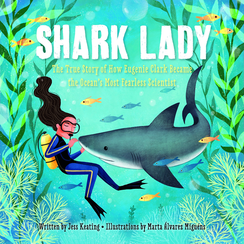
Shark Lady.* Jess Keating. Illustrated by Marta Alvarez Miguens. Sourcebooks, 2017 (K-4) Wonder, Lives to Learn From
As a little girl, Eugenie Clark visited the aquarium and became fascinated with sharks. Others saw them as “ugly and scary,” but their silvery fins and graceful glide fascinated Eugenie. Though many people tried to discourage her from following her dream, she was determined to make them her life’s work—studying hard, and eventually exploring the oceans and seas for sharks. This female pioneer in marine biology was fearless, and the book teaches us much about her discoveries. Lovely text and bright illustrations convey the excitement and beauty that Eugenie experienced while diving. *Available on Epic!
As a little girl, Eugenie Clark visited the aquarium and became fascinated with sharks. Others saw them as “ugly and scary,” but their silvery fins and graceful glide fascinated Eugenie. Though many people tried to discourage her from following her dream, she was determined to make them her life’s work—studying hard, and eventually exploring the oceans and seas for sharks. This female pioneer in marine biology was fearless, and the book teaches us much about her discoveries. Lovely text and bright illustrations convey the excitement and beauty that Eugenie experienced while diving. *Available on Epic!
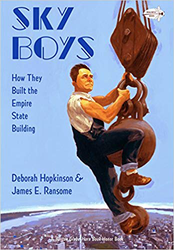
Sky Boys: How They Built the Empire State Building. Deborah Hopkinson. Illustrated by James E. Ransome. Schwartz & Wade, 2012.
(K-3) Hope, Love of Country
It’s the Depression and times are tough, but one project offers hope: a new building rising from the ground at the rate of one story per day. A young boy is fascinated, brings his jobless father to see the wonder, and wondrous things result. Bold illustrations and lyrical text inspire awe for one of the greatest construction projects ever and for the people who pulled it off.
(K-3) Hope, Love of Country
It’s the Depression and times are tough, but one project offers hope: a new building rising from the ground at the rate of one story per day. A young boy is fascinated, brings his jobless father to see the wonder, and wondrous things result. Bold illustrations and lyrical text inspire awe for one of the greatest construction projects ever and for the people who pulled it off.
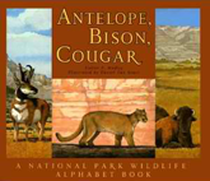
Antelope, Bison, Cougar. A National Park Wildlife Alphabet Book.
Steven P. Medley. Illustrated by Daniel San Souci. Yosemite Association, 2001 (K-3)Wonder
Daniel San Souci’s vivid watercolors capture the majesty of America’s national parks and the grace of the wild ones who call them home. Steven Medley’s richly informative text serves up intriguing detail on critters known and unknown. Did you know that the 2000 pound bison in Theodore Roosevelt National Park (ND) is a very good swimmer, who keeps his head, hump and tail above water as he paddles? Have you ever met the javelina in Chiricahua National Monument (AZ)? The text provides basic and not-so-basic information on animals and their national park habitats. The book will captivate third graders as well as Kindergartners, inspire wonder, curiosity, and an appreciation for the beauty and diversity of the land children call home.
Steven P. Medley. Illustrated by Daniel San Souci. Yosemite Association, 2001 (K-3)Wonder
Daniel San Souci’s vivid watercolors capture the majesty of America’s national parks and the grace of the wild ones who call them home. Steven Medley’s richly informative text serves up intriguing detail on critters known and unknown. Did you know that the 2000 pound bison in Theodore Roosevelt National Park (ND) is a very good swimmer, who keeps his head, hump and tail above water as he paddles? Have you ever met the javelina in Chiricahua National Monument (AZ)? The text provides basic and not-so-basic information on animals and their national park habitats. The book will captivate third graders as well as Kindergartners, inspire wonder, curiosity, and an appreciation for the beauty and diversity of the land children call home.
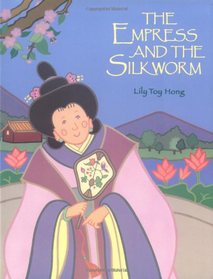
The Empress and the Silk Worm. Lily Toy Hong.
Albert Whitman and Co., 1995. (K-3) Imagination
Fictionalized account of the Chinese empress who was ingenious and curious enough to discover the secret of silk worms (2700 BC). Use with 2nd grade unit on Ancient China.
Albert Whitman and Co., 1995. (K-3) Imagination
Fictionalized account of the Chinese empress who was ingenious and curious enough to discover the secret of silk worms (2700 BC). Use with 2nd grade unit on Ancient China.
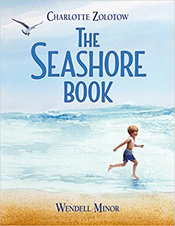
The Seashore Book. Charlotte Zolotow.
Illustrated by Wendell Minor. Charlesbridge, 2017. (K-2) Wonder
A mother explains to her son what its like at the sea’s edge, where the sky meets the sea, and the “swishswashing sound” of the waves lulls you to sleep on golden sand, and “two little gray sandpipers run past you … and when you wake up, you …see their claw prints like pencil lines in the sand. You rub your eyes and it seems there is nothing in the world except the sound of the wind and the rising and falling of the waves.” As children look longingly toward summer, this beautifully illustrated work will inspires hope and wonder.
Illustrated by Wendell Minor. Charlesbridge, 2017. (K-2) Wonder
A mother explains to her son what its like at the sea’s edge, where the sky meets the sea, and the “swishswashing sound” of the waves lulls you to sleep on golden sand, and “two little gray sandpipers run past you … and when you wake up, you …see their claw prints like pencil lines in the sand. You rub your eyes and it seems there is nothing in the world except the sound of the wind and the rising and falling of the waves.” As children look longingly toward summer, this beautifully illustrated work will inspires hope and wonder.
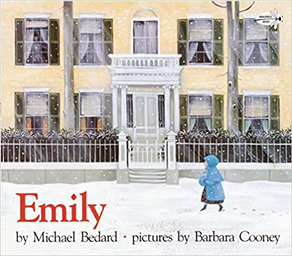
Emily. Michael Bedard. Illustrated by Barbara Cooney. Dragonfly Books, 2002 (K-2) Lives to Learn From, Imagination
Lovely picture book of Emily Dickinson, the quiet, gracious poet who wove beauty with her words.
Lovely picture book of Emily Dickinson, the quiet, gracious poet who wove beauty with her words.
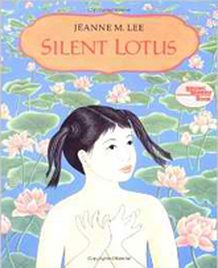
Silent Lotus. Jeanne M. Lee.
Farrar, Straus and Giroux, 1994. (K-3) Hope, Joy
Lotus is a gentle Cambodian child, born deaf and mute, but has a knack for imitating the graceful steps of the heron and egrets that live near her home. She is shunned by other children, growing up both lonely and longing for more. Her parents take her to the temple of the gods, hoping for a sign, and Lotus is mesmerized by the temple dancers. The king notices her grace and offers her the chance to learn the court dances, and in time she becomes the leading dancer of the Khmer kingdom. This is a stirring and superbly illustrated story of a child who, though different, realizes her talents, and through them hope and joy.
Farrar, Straus and Giroux, 1994. (K-3) Hope, Joy
Lotus is a gentle Cambodian child, born deaf and mute, but has a knack for imitating the graceful steps of the heron and egrets that live near her home. She is shunned by other children, growing up both lonely and longing for more. Her parents take her to the temple of the gods, hoping for a sign, and Lotus is mesmerized by the temple dancers. The king notices her grace and offers her the chance to learn the court dances, and in time she becomes the leading dancer of the Khmer kingdom. This is a stirring and superbly illustrated story of a child who, though different, realizes her talents, and through them hope and joy.

Queen of Physics: How Wu Chien Shiung Helped Unlock the Secrets of the Atom. Teresa Robeson. Illustrated by Rebecca Huang. Union Square Kids, 2019. (1-3) Diligence, Wonder, Perseverance, Courage. Women's History Month
Wu Chien Shiung was born in China in 1912 to an unusual family: parents who believed that girls had the same right to learn as boys, and who started a school to teach girls. The daughter's name meant “courageous hero.” And she indeed grew up to do great things, eventually traveling to Berkeley, California to do groundbreaking work in nuclear physics. As a woman of Asian descent in the 1930s, Wu Chien had an uphill battle in her field, but was undeterred. Geared to younger kids, this book does a good job of explaining Wu’s work in a way that everyone can understand, but the subject material and glossary at the end ensure that adults and older kids will also learn a lot from this book.
Wu Chien Shiung was born in China in 1912 to an unusual family: parents who believed that girls had the same right to learn as boys, and who started a school to teach girls. The daughter's name meant “courageous hero.” And she indeed grew up to do great things, eventually traveling to Berkeley, California to do groundbreaking work in nuclear physics. As a woman of Asian descent in the 1930s, Wu Chien had an uphill battle in her field, but was undeterred. Geared to younger kids, this book does a good job of explaining Wu’s work in a way that everyone can understand, but the subject material and glossary at the end ensure that adults and older kids will also learn a lot from this book.

Between the Lines: How Ernie Barnes Went From the Football Field to the Art Gallery. Sandra Neil Wallace. Illustrated by Bryan Collier. Simon & Schuster, 2018. (1-4) Perseverance, Imagination, Black History Month.
Bryan Collier brings his considerable talents to the true story of a young boy with a passion for painting and drawing. He would grow up to play professional football but he never lost his love of art, and resolved to follow his dream after his retirement from the NFL. At a time when African-American art was not seen as cutting edge, Barnes lived a life bringing together football and art—beginning with a painting of football players waiting on the bench. After his successful football career, he was offered a football player’s salary by the owner of the New York Jets to create his dynamic sports paintings. His paintings, characterized by elongated limbs and lithe movement, are sought after today.
Bryan Collier brings his considerable talents to the true story of a young boy with a passion for painting and drawing. He would grow up to play professional football but he never lost his love of art, and resolved to follow his dream after his retirement from the NFL. At a time when African-American art was not seen as cutting edge, Barnes lived a life bringing together football and art—beginning with a painting of football players waiting on the bench. After his successful football career, he was offered a football player’s salary by the owner of the New York Jets to create his dynamic sports paintings. His paintings, characterized by elongated limbs and lithe movement, are sought after today.
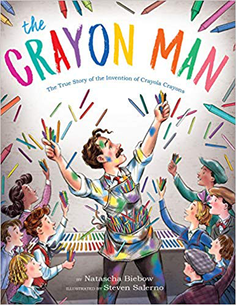
The Crayon Man. The True Story of the Invention of Crayola Crayons. * Natascha Biebow. Illustrated by Steven Salerno. Houghton Mifflin Harcourt, 2019 (1-4)Imagination, Lives to Learn From, Diligence, Perseverance
Edwin Binney was an inventive man who loved color – but he worked in a factory that made carbon black: for ink, for stove polish and for shoe polish. He listened when his wife told him their children needed better drawing tools, instead of the dull, clunky crayons they had. Edwin got right on it,experimenting with different bases and pigments that kept bright colors. In 1903, they shipped their "Crayolas" to market – eight to a box for a nickel. They were a hit! Edwin went on to make many more colors. A (not surprisingly) very colorful book with lively illustrations, plus photos of the current factory that makes all 64 of the crayon colors. Children who are curious about science and minerals will enjoy the description of pigments used. *Available on Epic!
Edwin Binney was an inventive man who loved color – but he worked in a factory that made carbon black: for ink, for stove polish and for shoe polish. He listened when his wife told him their children needed better drawing tools, instead of the dull, clunky crayons they had. Edwin got right on it,experimenting with different bases and pigments that kept bright colors. In 1903, they shipped their "Crayolas" to market – eight to a box for a nickel. They were a hit! Edwin went on to make many more colors. A (not surprisingly) very colorful book with lively illustrations, plus photos of the current factory that makes all 64 of the crayon colors. Children who are curious about science and minerals will enjoy the description of pigments used. *Available on Epic!
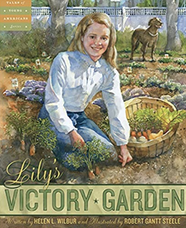
Lily's Victory Garden. (Tales of Young Americans.) Helen L. Wilbur. Illustrated by Robert Gantt Steele. Sleeping Bear Press, 2010. (1-4) Hope, Perseverance, Love of Country, Lives to Learn From
Lily and her brother collect scrap metal for the war effort, but one house is particularly touchy to visit: the Bishop household, the parents of the first soldier from Lily's town to die in the war. Lily wants to have a victory garden, but is told she's too young to apply for the lottery for land plots. Where can she find land to help the war effort? In the Bishops' garden, as it turns out. As the story unfolds both Lily and the Bishops will learn lessons about hope.
Lily and her brother collect scrap metal for the war effort, but one house is particularly touchy to visit: the Bishop household, the parents of the first soldier from Lily's town to die in the war. Lily wants to have a victory garden, but is told she's too young to apply for the lottery for land plots. Where can she find land to help the war effort? In the Bishops' garden, as it turns out. As the story unfolds both Lily and the Bishops will learn lessons about hope.
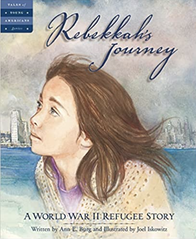
Rebekkah's Journey: A World War II Refugee Story. (Tales of Young Americans.) Ann E. Burg. Illustrated by Joel Iskowitz. Sleeping Bear Press, 2006. (1-4) Hope, Courage.
Rebekkah is among many Jews who must to leave her home because of the threat of the Nazis. Missing her beloved Papa and confused and disoriented by this new land, Rebekkah rises to the occasion of a new language and strange new experiences to help encourage her mother as they live with other Jewish refugees on a vacant army base in New York.
Rebekkah is among many Jews who must to leave her home because of the threat of the Nazis. Missing her beloved Papa and confused and disoriented by this new land, Rebekkah rises to the occasion of a new language and strange new experiences to help encourage her mother as they live with other Jewish refugees on a vacant army base in New York.
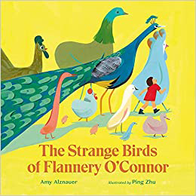
The Strange Birds of Flannery O’Connor. Amy Alznauer. Illustrated by Pin Zhu. Enchanted Lion Books, 2020. (2-4) Wonder, Lives to Learn From.
“Right from the start young Flannery took a shine to chickens.” How’s that for an opening line? This large, quirky, and wondrous book, celebrates the life and vision of American literary great Flannery O’Connor. From her childhood, Flannery stared and drew to penetrate meaning. She was drawn to strangeness, particularly the strangeness and majesty of birds. In them she saw our quirks, majesty, violence, sadness, and the design of a greater power. Not surprisingly, the peacock was her favorite. The vivid illustrations immerse the reader in the bold sashay of color that was her life: a witness to hope amid suffering.
“Right from the start young Flannery took a shine to chickens.” How’s that for an opening line? This large, quirky, and wondrous book, celebrates the life and vision of American literary great Flannery O’Connor. From her childhood, Flannery stared and drew to penetrate meaning. She was drawn to strangeness, particularly the strangeness and majesty of birds. In them she saw our quirks, majesty, violence, sadness, and the design of a greater power. Not surprisingly, the peacock was her favorite. The vivid illustrations immerse the reader in the bold sashay of color that was her life: a witness to hope amid suffering.
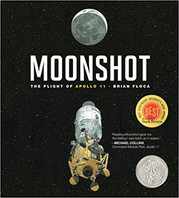
Moonshot: The Flight of Apollo 11. Brian Floca.
National Geographic, 2010. (K-4) Hope, Wonder, Love of Country
A rich and crisply written account of the 1969 lunar expedition. Floca’s text brims with detail both accurate and poetic, as three American astronauts don suits and gloves, strap themselves sideways into their seats and roar off on a tower of fuel and flame make history. A silent moon awaits them, and they see their home in a new light. A grand adventure story, all the more amazing because it’s true.
National Geographic, 2010. (K-4) Hope, Wonder, Love of Country
A rich and crisply written account of the 1969 lunar expedition. Floca’s text brims with detail both accurate and poetic, as three American astronauts don suits and gloves, strap themselves sideways into their seats and roar off on a tower of fuel and flame make history. A silent moon awaits them, and they see their home in a new light. A grand adventure story, all the more amazing because it’s true.
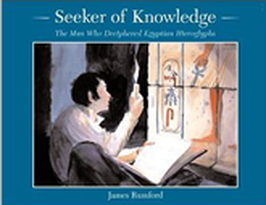
Seeker of Knowledge: The Man Who Deciphered Egyptian Hieroglyphics James Rumford. HMH Books, 2003. (K-5) Wonder
In this fascinating volume Rumford chronicles the untiring efforts of nineteenth century Frenchman, Jean-Francois Champollion to decode Egyptian hieroglyphics or picture writing. The scholar’s interest in Egypt was awakened as a boy when Napoleon marched into Egypt. Champollion’s childhood fascination grew to an adult passion, as he learned of the discovery of the Rosetta stone, and eventually cracked the code. Rumford’s illustrations and story are a complete delight, proving once again that “wonder is the first step on the path to knowledge.”
In this fascinating volume Rumford chronicles the untiring efforts of nineteenth century Frenchman, Jean-Francois Champollion to decode Egyptian hieroglyphics or picture writing. The scholar’s interest in Egypt was awakened as a boy when Napoleon marched into Egypt. Champollion’s childhood fascination grew to an adult passion, as he learned of the discovery of the Rosetta stone, and eventually cracked the code. Rumford’s illustrations and story are a complete delight, proving once again that “wonder is the first step on the path to knowledge.”
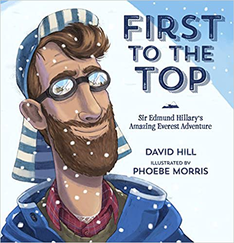
First to the Top. David Hill. Illustrated by Phoebe Morris. Penguin Random House, 2016. (K-3) Hope, Joy
Excellent young child's overview of the shy New Zealand child, who followed his heart and grew in confidence and skill. Striking illustrations. Respectful and insightful portrayal of the friendships with Himalayan mountaineers and support teams, and of Hillary's lifelong friendship with Tenzing Norgay.
Excellent young child's overview of the shy New Zealand child, who followed his heart and grew in confidence and skill. Striking illustrations. Respectful and insightful portrayal of the friendships with Himalayan mountaineers and support teams, and of Hillary's lifelong friendship with Tenzing Norgay.
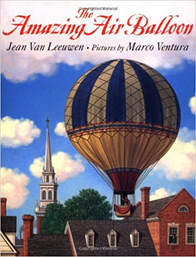
The Amazing Air Balloon. Jean Van Leeuwen. Illustrated by Marco Ventura. Phyllis Fogelman Books, 2003 (K-4)Wonder
The inspiring story of Edward Warren, the orphaned thirteen-year-old apprentice, who became the first American to ascend in a hot air balloon. Set in colonial times and brought to life with vibrant oil paintings, Jean Van Leeuwen’s story reinforces the themes of wonder and passionate pursuit of one’s dreams. The wiry teenager is able to take this flight because the balloon’s creator, Peter Carnes, is too heavy to take it up! Evocative illustrations bring the period to life.
The inspiring story of Edward Warren, the orphaned thirteen-year-old apprentice, who became the first American to ascend in a hot air balloon. Set in colonial times and brought to life with vibrant oil paintings, Jean Van Leeuwen’s story reinforces the themes of wonder and passionate pursuit of one’s dreams. The wiry teenager is able to take this flight because the balloon’s creator, Peter Carnes, is too heavy to take it up! Evocative illustrations bring the period to life.
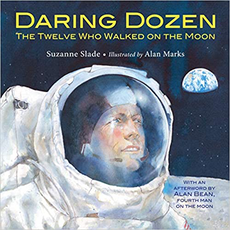
Daring Dozen: The Twelve Who Walked on the Moon.* Susan Slade. Illustrated by Alan Marks. Charlesbridge, 2019. (K-6)
Lives to learn from, Wonder, Courage
Neil Armstrong took the first step on the moon in 1969, but eleven other Apollo astronauts succeeded him in the next four years. Beautiful text and exceptional watercolors bring to life the unique and inspirational journey, and show how the various missions built on the work of the previous. This is one of the rare books that can be enjoyed by children at various stages of the elementary school continuum. The lively text (in story form) makes it come alive for younger readers, while detailed backmatter (a timeline, information about the rocket ships and crews) make it a great resource for older kids. *Available on Epic!
Lives to learn from, Wonder, Courage
Neil Armstrong took the first step on the moon in 1969, but eleven other Apollo astronauts succeeded him in the next four years. Beautiful text and exceptional watercolors bring to life the unique and inspirational journey, and show how the various missions built on the work of the previous. This is one of the rare books that can be enjoyed by children at various stages of the elementary school continuum. The lively text (in story form) makes it come alive for younger readers, while detailed backmatter (a timeline, information about the rocket ships and crews) make it a great resource for older kids. *Available on Epic!
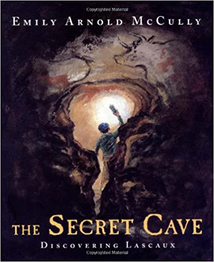
The Secret Cave: Discovering Lascaux. Emily Arnold McCully.
Farrar, Straus and Giroux, 2010. (1-4) Wonder
Three French boys looking for buried treasure discover it: but in an unexpected form. In 1940 the curious kids were exploring an underground cave, searching for rumored gold, when they happened instead upon 17,000 year-old cave art. With suspenseful writing and lush illustrations, McCully retells the fantastic true story of re-discovering humanity's first known works of art. The silent cave walls, painted with bulls, boar, reindeer and more, come to life with startling force. The boys are awed. They do not immediately reveal their find, but eventually share word of it with other children, and a trusted teacher, who introduces an expert to authenticate the marvel. The boys become guardians of the cave and heroes for the town. A marvelous tale of how a child's sense of wonder, can introduce to the world a great wonder.
Farrar, Straus and Giroux, 2010. (1-4) Wonder
Three French boys looking for buried treasure discover it: but in an unexpected form. In 1940 the curious kids were exploring an underground cave, searching for rumored gold, when they happened instead upon 17,000 year-old cave art. With suspenseful writing and lush illustrations, McCully retells the fantastic true story of re-discovering humanity's first known works of art. The silent cave walls, painted with bulls, boar, reindeer and more, come to life with startling force. The boys are awed. They do not immediately reveal their find, but eventually share word of it with other children, and a trusted teacher, who introduces an expert to authenticate the marvel. The boys become guardians of the cave and heroes for the town. A marvelous tale of how a child's sense of wonder, can introduce to the world a great wonder.
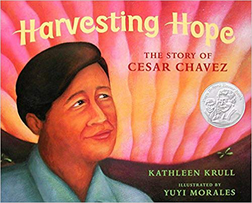
Harvesting Hope. The Story of Cesar Chavez. Kathleen Krull.
Illustrated by Yuyi Morales. Harcourt, 2003 (1-3) Hope, Responsibility, Courage, Lives to Learn From
Cesar Chavez grew up on his family’s ranch in Arizona. In 1937, at the depths of the Depression, a devastating drought took the farm into foreclosure, and the family moved to California to work on other people’s farms. Migrant families worked hard, but at this time of Depression, they were underpaid and unwelcome in the towns and schools. Cesar left school after eighth grade to work in the fields, so his mother wouldn't have to. He listened to those who called for reforms, and himself began to speak out for fair hiring and higher wages for farm workers. Cesar espoused non-violence in the quest for justice, leading a march from Delano to Sacramento with thousands of farm workers for fair wages. This lead to the formation of the United Farm Workers Union. It was a great victory and the beginning of reform for the industry. Vibrant, mural-like illustrations.
Illustrated by Yuyi Morales. Harcourt, 2003 (1-3) Hope, Responsibility, Courage, Lives to Learn From
Cesar Chavez grew up on his family’s ranch in Arizona. In 1937, at the depths of the Depression, a devastating drought took the farm into foreclosure, and the family moved to California to work on other people’s farms. Migrant families worked hard, but at this time of Depression, they were underpaid and unwelcome in the towns and schools. Cesar left school after eighth grade to work in the fields, so his mother wouldn't have to. He listened to those who called for reforms, and himself began to speak out for fair hiring and higher wages for farm workers. Cesar espoused non-violence in the quest for justice, leading a march from Delano to Sacramento with thousands of farm workers for fair wages. This lead to the formation of the United Farm Workers Union. It was a great victory and the beginning of reform for the industry. Vibrant, mural-like illustrations.
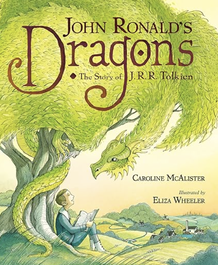
John Ronald's Dragons: The Story of J.R.R. Tolkien. Caroline McAllister. Illustrated by Eliza Wheeler. Roaring Book Press, 2017. (1-4) Wonder, Wisdom, Diligence, Imagination.
John Ronald Reuel Tolkien would become one of the greatest fantasy writers the world would ever know, but he started out his life as a young boy obsessed with dragons. The author's and illustrator's obvious familiarity with the stories of Tolkien leads to clever tie-ins between John Ronald's childhood experience and his later work (intricate elven windows in the library where he holds a tea party, his headmaster's long beard and smoking pipe...) Vivid, lighthearted illustrations make this a joy to read for all ages.
John Ronald Reuel Tolkien would become one of the greatest fantasy writers the world would ever know, but he started out his life as a young boy obsessed with dragons. The author's and illustrator's obvious familiarity with the stories of Tolkien leads to clever tie-ins between John Ronald's childhood experience and his later work (intricate elven windows in the library where he holds a tea party, his headmaster's long beard and smoking pipe...) Vivid, lighthearted illustrations make this a joy to read for all ages.
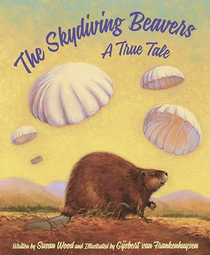
The Skydiving Beavers. A True Tale. Susan Wood. Illustrated by Gijsbert van Frankenhuyzen. Sleeping Bear Press, 2017. (1-4) Stewardship, Imagination, Wonder
McCall, Idaho is a beautiful place to live and beavers have thought so for a long time. After World War II, humans decided to settle there too, and the two species collided. Beaver dams flooded roads. And new homes eliminated foraging lands for beavers. Elmo Heter, who worked for the Idaho Department of Fish and Game, did not want to see the beavers die out; he came up with an imaginative solution. Open lands in Idaho miles away suited the beaver's needs perfectly, so why not use some World War II technology to give the beavers a new home? You guessed it. In 1948, seventy beavers, led by a courageous beaver named Geronimo (who seemed to enjoy the practice runs) parachuted safely into their new home. A playful, funny and true story with marvelous illustrations. (And also explanations of why this wouldn't work today...)
McCall, Idaho is a beautiful place to live and beavers have thought so for a long time. After World War II, humans decided to settle there too, and the two species collided. Beaver dams flooded roads. And new homes eliminated foraging lands for beavers. Elmo Heter, who worked for the Idaho Department of Fish and Game, did not want to see the beavers die out; he came up with an imaginative solution. Open lands in Idaho miles away suited the beaver's needs perfectly, so why not use some World War II technology to give the beavers a new home? You guessed it. In 1948, seventy beavers, led by a courageous beaver named Geronimo (who seemed to enjoy the practice runs) parachuted safely into their new home. A playful, funny and true story with marvelous illustrations. (And also explanations of why this wouldn't work today...)
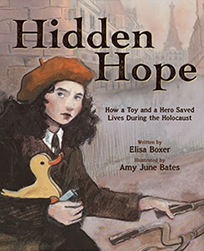
Hidden Hope: How a Toy and a Hero Saved Lives During the Holocaust. Elisa Boxer. Illustrated by Amy June Bates. Abrams Books for Young Readers, 2023. (1-4) Courage, Hope
Set in France, the true story of teen Judith Geller, who delivered life-saving identity and exit papers to Jews in the disguise of a Christian social worker. She carried a hollow wooden toy duck with the secret papers inside—and it escaped the notice of the Nazis, even when she was stopped in the street. A hauntingly illustrated book on the Holocaust that does not shy away from the reality of the time, but is also appropriate for younger readers because of its simple language and focus on a young person and her heroic work.
Set in France, the true story of teen Judith Geller, who delivered life-saving identity and exit papers to Jews in the disguise of a Christian social worker. She carried a hollow wooden toy duck with the secret papers inside—and it escaped the notice of the Nazis, even when she was stopped in the street. A hauntingly illustrated book on the Holocaust that does not shy away from the reality of the time, but is also appropriate for younger readers because of its simple language and focus on a young person and her heroic work.
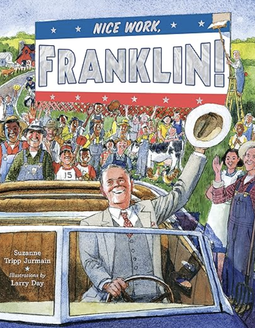
Nice Work, Franklin! Suzanne Tripp Jurmain. Illustrated by Larry Day. Dial Books, 2016. Perseverance, Courage, Hope, Lives to Learn From (1-4)
The upbeat and inspirational story of how Franklin Delano Roosevelt met some of life's biggest challenges. At age 39, as a successful political figure, he contracted polio which left him paralyzed for life. Lesser men might have retired at that point, but not Franklin! He taught himself to use braces, re-learn walking, then went on to become governor of New York and President. As President at the depths of the catastrophic Great Depression, he used the lessons polio taught him - when one solution doesn't work, try another, but above all try something! Our only handicapped president was also the only candidate elected four times to the office. This biography follows FDR from young adulthood to 1937.
The upbeat and inspirational story of how Franklin Delano Roosevelt met some of life's biggest challenges. At age 39, as a successful political figure, he contracted polio which left him paralyzed for life. Lesser men might have retired at that point, but not Franklin! He taught himself to use braces, re-learn walking, then went on to become governor of New York and President. As President at the depths of the catastrophic Great Depression, he used the lessons polio taught him - when one solution doesn't work, try another, but above all try something! Our only handicapped president was also the only candidate elected four times to the office. This biography follows FDR from young adulthood to 1937.

Determined Dreamer: The Story of Marie Curie. Deborah Hopkinson. Illustrated by Jenn Hill. Harper Collins, 2024 (1-5) Diligence, Imagination. A little Polish girl, Marie Sklodowska, had a strong sense that she was born to be a scientist. She went to Paris to study. With hard work, creativity, and perseverance, she made her dream come true. Many sufferings in her life—the loss of her mother and sister, then the loss of her beloved husband and research parter Pierre—did not hold her back from pursuing the hard work of discovering radium and polonium, which she named after her childhood home. Evocative, graceful illustrations accompany the story of a too-neglected figure in the history of science.
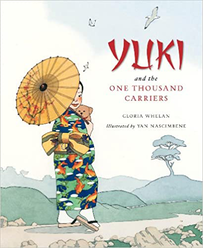
Yuki and the One Thousand Carriers.* Gloria Whelan.
Sleeping Bear Press, 2008. (2-5) Wonder, Hope
Set in Shogun Japan, the mesmerizing illustrations (evocative of Japanese woodcuts) make the book a treasure. Yuki, the daughter of a high ranking official, travels with her family from Kyoto to Edo (Tokyo), home of the shogun. She is uneasy about leaving her home in Kyoto for their new life in Edo, and she is charged by her teacher with writing a haiku each day to recall the fifty-three day journey. The haikus sing. Lyrically written, this book celebrates the beauty of Japan and a child's hope for new life. It also introduces children to a land where the privileged are carried in litters (palanquins) on the backs of carriers, one thousand of whom bend to their task. In Core Knowledge schools this could be used fruitfully in second grade (Culture of Japan unit) or fifth grade (Shogun Japan; haiku). *Available on Epic!
Sleeping Bear Press, 2008. (2-5) Wonder, Hope
Set in Shogun Japan, the mesmerizing illustrations (evocative of Japanese woodcuts) make the book a treasure. Yuki, the daughter of a high ranking official, travels with her family from Kyoto to Edo (Tokyo), home of the shogun. She is uneasy about leaving her home in Kyoto for their new life in Edo, and she is charged by her teacher with writing a haiku each day to recall the fifty-three day journey. The haikus sing. Lyrically written, this book celebrates the beauty of Japan and a child's hope for new life. It also introduces children to a land where the privileged are carried in litters (palanquins) on the backs of carriers, one thousand of whom bend to their task. In Core Knowledge schools this could be used fruitfully in second grade (Culture of Japan unit) or fifth grade (Shogun Japan; haiku). *Available on Epic!
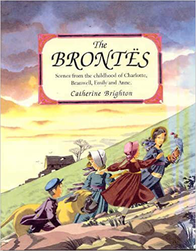
The Brontes: Scenes from the Childhood of Charlotte, Branwell, Emily, and Anne. Catherine Brighton. Frances Lincoln Children's Books, 2005. (2-4)Imagination
This delightful childhood biography of the Bronte sisters captures their wonder at the richness of life and their unique gifts of imagination. Calling themselves the four genii, they begin to create fantasy kingdoms in their minds and on paper.
This delightful childhood biography of the Bronte sisters captures their wonder at the richness of life and their unique gifts of imagination. Calling themselves the four genii, they begin to create fantasy kingdoms in their minds and on paper.

Alfred Nobel: The Man Behind the Peace Prize.* Kathy Jo Wargin. Illustrated by Zachary Pullen. Sleeping Bear Press, 2009. (2-4) Imagination, Diligence, Lives to Learn From
This strikingly illustrated biography shows how Swedish scientist Alfred Nobel, best known for inventing dynamite, thought his inventions would benefit, not hurt humankind. He was diligent in making dynamite safe for construction workers. He was horrified that it became a tool of war. As he thought of the legacy he would leave behind, he did not want it to be one of destruction. He decided instead to leave his immense wealth to those who would make the world a better place. He designated the Nobel Prizes for accomplishments in Physics, Chemistry, Medicine, Literature and most important: Peace.*Available on Epic!
This strikingly illustrated biography shows how Swedish scientist Alfred Nobel, best known for inventing dynamite, thought his inventions would benefit, not hurt humankind. He was diligent in making dynamite safe for construction workers. He was horrified that it became a tool of war. As he thought of the legacy he would leave behind, he did not want it to be one of destruction. He decided instead to leave his immense wealth to those who would make the world a better place. He designated the Nobel Prizes for accomplishments in Physics, Chemistry, Medicine, Literature and most important: Peace.*Available on Epic!
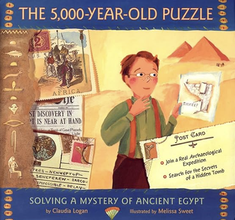
The 5,000 Year Old Puzzle: Solving a Mystery of Ancient Egypt. Claudia Logan. Illustrated by Melissa Sweet. Farrar, Straus and Giroux, 2002. (3-4) Wonder, Stewardship, Diligence.
Young sleuths will enjoy this educational deep dive into an ancient Egyptian archeological dig. In 1922, King Tut's tomb was discovered, and a real expedition went to the site, led by Dr. George Reisner. This book tells the tale of this expedition through the diaries of a fictional young Will Hunt, allowing readers to follow all its twists and turns: a glimpse into the science of archaeology and its high stakes for preservation, as well as the amazing discoveries that can be made along the way.
Young sleuths will enjoy this educational deep dive into an ancient Egyptian archeological dig. In 1922, King Tut's tomb was discovered, and a real expedition went to the site, led by Dr. George Reisner. This book tells the tale of this expedition through the diaries of a fictional young Will Hunt, allowing readers to follow all its twists and turns: a glimpse into the science of archaeology and its high stakes for preservation, as well as the amazing discoveries that can be made along the way.
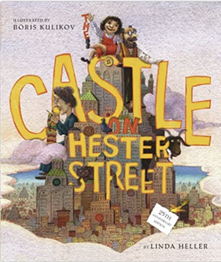
The Castle on Hester Street. Linda Heller. Illustrated by Boris Kulikov. Simon and Schuster Books, 2007. (2-4) Imagination, Immigrant Heritage Month.
Grandpa's version of how he and Grandma came to America from Russia is quite different from Grandma's. Julie tries to figure if they flew on a golden cart pulled by a singing goat named Moishe or did they endure an overcrowded boat and a stormy ocean crossing? Each tale Grandpa spins grows wilder while Grandma tells a different story. The lively story and whimsical illustrations show how hard times can be made easier with a little imagination.
Grandpa's version of how he and Grandma came to America from Russia is quite different from Grandma's. Julie tries to figure if they flew on a golden cart pulled by a singing goat named Moishe or did they endure an overcrowded boat and a stormy ocean crossing? Each tale Grandpa spins grows wilder while Grandma tells a different story. The lively story and whimsical illustrations show how hard times can be made easier with a little imagination.
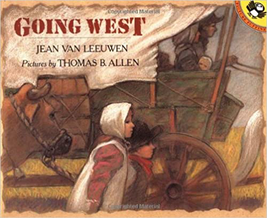
Going West. Jean Van Leeuwen. Illustrated by Thomas B. Allen. Dial Books, 1992. (2-4) Courage, Hope & Joy
Beautifully illustrated tale of a family who leaves all behind, braves a covered wagon journey, storms, drought, and danger to settle in the west, a land of opportunity, "where anything you planted would grow and a farm could stretch out as far as the eye could see."
Beautifully illustrated tale of a family who leaves all behind, braves a covered wagon journey, storms, drought, and danger to settle in the west, a land of opportunity, "where anything you planted would grow and a farm could stretch out as far as the eye could see."
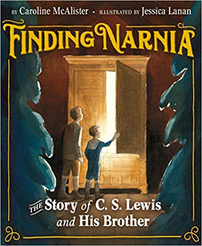
Finding Narnia. The Story of C.S. Lewis and His Brother. Caroline McAlister, Illustrated by Jessica Lanan. Roaring Brook Press, 2019. (2-4) Imagination, Lives to Learn From, Wonder, Loyalty,
Children (and parents and teachers) who love C.S. Lewis's Chronicles of Narnia will delight in this gorgeous biography. McAlister tells the tale of two brothers: C.S. Lewis ("Jack") grew up with a younger brother, Warnie, and though they differed in temperament, they delighted in playing imaginary games together. A massive wardrobe in their childhood home became the stage for adventures of knights, talking animals, and magical trains. The brothers stood by each other when their mother passed away, and when they were sent to boarding school. They each served in the army during WWI and later they moved into a house together along with the wardrobe they played in as children. During WW II they provided a safe home for two girls from London, who were also fascinated with the wardrobe. C.S., inspired, began to write the Narnia series. The brothers had a life-long collaboration: C.S. wrote in long hand and Warnie typed up his manuscripts. Subtle watercolors and lyrical text quietly tell the story of these two brothers and life long friends.
Children (and parents and teachers) who love C.S. Lewis's Chronicles of Narnia will delight in this gorgeous biography. McAlister tells the tale of two brothers: C.S. Lewis ("Jack") grew up with a younger brother, Warnie, and though they differed in temperament, they delighted in playing imaginary games together. A massive wardrobe in their childhood home became the stage for adventures of knights, talking animals, and magical trains. The brothers stood by each other when their mother passed away, and when they were sent to boarding school. They each served in the army during WWI and later they moved into a house together along with the wardrobe they played in as children. During WW II they provided a safe home for two girls from London, who were also fascinated with the wardrobe. C.S., inspired, began to write the Narnia series. The brothers had a life-long collaboration: C.S. wrote in long hand and Warnie typed up his manuscripts. Subtle watercolors and lyrical text quietly tell the story of these two brothers and life long friends.

What Miss Mitchell Saw. Hayley Barrett. Illustrated by Diana Sudyka. Beach Lane Books, 2019. (2-4) Wonder, Diligence, Women’s History Month.
Nantucket-born Maria Mitchell grows up enthralled by the stars, and the sky is her sea. First as a teacher and then as a librarian, she keeps her sense of wonder alive, scanning the skies nightly and naming all the heavenly bodies she sees there. Then, on an October evening in 1847, she sees something never before seen—a new comet. Will Miss Mitchell get the credit for sighting the comet first, even though it takes so long for her letter to reach Europe that a Vatican astronomer claims the comet in the meantime? Yes, she will! Beguiling illustrations of the night sky, an informative fact section at the end, and the distinctive influence of Mitchell’s Quaker upbringing will interest both younger and older kids.
Nantucket-born Maria Mitchell grows up enthralled by the stars, and the sky is her sea. First as a teacher and then as a librarian, she keeps her sense of wonder alive, scanning the skies nightly and naming all the heavenly bodies she sees there. Then, on an October evening in 1847, she sees something never before seen—a new comet. Will Miss Mitchell get the credit for sighting the comet first, even though it takes so long for her letter to reach Europe that a Vatican astronomer claims the comet in the meantime? Yes, she will! Beguiling illustrations of the night sky, an informative fact section at the end, and the distinctive influence of Mitchell’s Quaker upbringing will interest both younger and older kids.
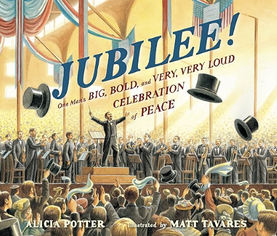
Jubilee!: One Man's Big, Bold, and Very, Very Loud Celebration of Peace. Alicia Potter. Illustrated by Matt Tavares. Candlewick, 2014. (2-5) Joy, Gratitude, Love of Country.
Irish American bandmaster Patrick Sarsfield Gilmore had a dream. He'd come to the US in 1848 and enlisted with the 24th Massachusetts Volunteers in his adopted country's Civil War (writing a tune you might recognize) and when the war ended, he wanted to celebrate peace with the biggest concert the world had ever seen: a Peace Jubilee! This light-hearted and yet weighty tale will keep children riveted throughout: the year is 1867. Can Gilmore bring together 12 cannons, 10,000 singers, 40 church bells, and 1,000 musicians into one glorious sound? An intriguing and little-known story about the composer of "When Johnny Comes Marching Home" and one of America's greatest military musicians.
Irish American bandmaster Patrick Sarsfield Gilmore had a dream. He'd come to the US in 1848 and enlisted with the 24th Massachusetts Volunteers in his adopted country's Civil War (writing a tune you might recognize) and when the war ended, he wanted to celebrate peace with the biggest concert the world had ever seen: a Peace Jubilee! This light-hearted and yet weighty tale will keep children riveted throughout: the year is 1867. Can Gilmore bring together 12 cannons, 10,000 singers, 40 church bells, and 1,000 musicians into one glorious sound? An intriguing and little-known story about the composer of "When Johnny Comes Marching Home" and one of America's greatest military musicians.
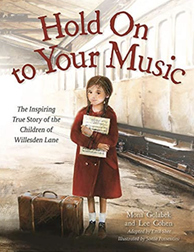
Hold on to your Music. Mona Golabek and Lee Cohen. Illlustrated by Sonia Possentini. Little, Brown Books, 2021. (2-5) Courage, Hope, Immigrant History
A gifted piano student in pre-World War II Vienna, Lisa Jura’s life changed when the Nazis forbade her teacher to continue lessons with this Jewish student. Lisa's parents sought to protect her and put her on a Kindertransport train to Britain, reminding her to “Hold on to your music. It will be your best friend.” Refugee Lisa is lucky to find support for her music within the children’s home on Willisden Lane, and her music gave hope to others. While life around her is difficult and uncertain, Lisa's music lifts spirits, provides hope, and helps her and others confront the difficult times. True story of this concert pianist, who was eventually accepted into the Royal Academy of Music. (For second to fourth or fifth because of content.)
A gifted piano student in pre-World War II Vienna, Lisa Jura’s life changed when the Nazis forbade her teacher to continue lessons with this Jewish student. Lisa's parents sought to protect her and put her on a Kindertransport train to Britain, reminding her to “Hold on to your music. It will be your best friend.” Refugee Lisa is lucky to find support for her music within the children’s home on Willisden Lane, and her music gave hope to others. While life around her is difficult and uncertain, Lisa's music lifts spirits, provides hope, and helps her and others confront the difficult times. True story of this concert pianist, who was eventually accepted into the Royal Academy of Music. (For second to fourth or fifth because of content.)
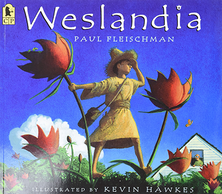
Weslandia. Paul Fleischman. Illustrated by Kevin Hawkes. Candlewick, 2002. (3-6) Imagination, Wonder, Stewardship
Wesley doesn’t think like other children. From his suburban backyard he imagines his own self-sufficient civilization, in which fantastical plants feed, clothe, shelter and provide many unexpected benefits in the hands of a creative kid. There is no waste. The intricate illustrations will draw the children in as they contemplate the connectedness of all things.
Wesley doesn’t think like other children. From his suburban backyard he imagines his own self-sufficient civilization, in which fantastical plants feed, clothe, shelter and provide many unexpected benefits in the hands of a creative kid. There is no waste. The intricate illustrations will draw the children in as they contemplate the connectedness of all things.
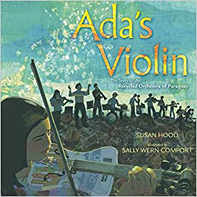
Ada’s Violin: The Story of the Recycled Orchestra of Paraguay. Susan Hood. Illustrated by Sally Wern Comport. Simon and Schuster, 2016. (2-5) Imagination, Hope, Stewardship
Eleven-year-old Ada is growing up in Cateura, a bleak town perched on a landfill in Paraguay. Ada thinks the garbage truck that arrives each morning is “a box of surprises. One never knew what might be inside.” When music teacher Favio Chavez arrives in her town, Ada is entranced. Chavez teaches children how to fashion musical instruments from the debris. “The world sends us garbage. We send back music.” In this true story, the “Recycled Orchestra” is his gift to the children of the slums, and Ada triumphs. The illustrations (often collages) capture the hope of the children, and the lyrical text charts their strides. A book of stewardship, as well as resourcefulness, and of hope in the darkness.
Eleven-year-old Ada is growing up in Cateura, a bleak town perched on a landfill in Paraguay. Ada thinks the garbage truck that arrives each morning is “a box of surprises. One never knew what might be inside.” When music teacher Favio Chavez arrives in her town, Ada is entranced. Chavez teaches children how to fashion musical instruments from the debris. “The world sends us garbage. We send back music.” In this true story, the “Recycled Orchestra” is his gift to the children of the slums, and Ada triumphs. The illustrations (often collages) capture the hope of the children, and the lyrical text charts their strides. A book of stewardship, as well as resourcefulness, and of hope in the darkness.
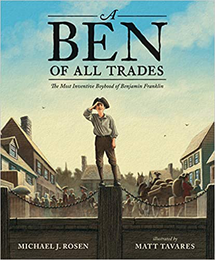
A Ben of All Trades: The Most Inventive Boyhood of Benjamin Franklin. Michael J. Rosen. Illustrated by Matt Tavares. Candlewick Press, 2020. (3-5) Imagination, Lives to Learn From.
This wryly written biography was inspired by Benjamin Franklin's own autobiography and captures his curious and inventive nature. Bored by anything that involved repetition, young Ben consistently sought out novelty, and invented devices that allowed improvement (his own hand-carved, swimming fins). His father feared he'd never amount to more than a "wool-gatherer," but his versatility and ingenuity are on full display in this beautifully illustrated and quaintly told account of his youth. Antsy, inventive kids will love this one. Excellent accompaniment to either third or fourth grade Core Knowledge study of Franklin.
This wryly written biography was inspired by Benjamin Franklin's own autobiography and captures his curious and inventive nature. Bored by anything that involved repetition, young Ben consistently sought out novelty, and invented devices that allowed improvement (his own hand-carved, swimming fins). His father feared he'd never amount to more than a "wool-gatherer," but his versatility and ingenuity are on full display in this beautifully illustrated and quaintly told account of his youth. Antsy, inventive kids will love this one. Excellent accompaniment to either third or fourth grade Core Knowledge study of Franklin.
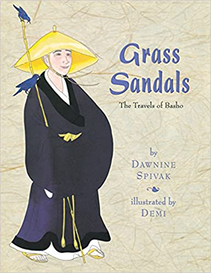
Grass Sandals: The Travels of Basho. Dawnine Spivak.
Illustrated by Demi. Atheneum Books, 1997. (2-5) Wonder
Basho, a Japanese poet renown for haiku, “would sit in the doorway of his small house, sit with his breakfast bowl, look out at the river and mountains, and pour his tea in the company of morning glories.” One day Basho closes up his small home and begins his walk across Japan in his grass sandals and black robe. With simple, elegant illustrations and quiet, playful text, Grass Sandals invites elementary school children to experience the gentle beauty of nature, Japan, and the simplicity of haiku. The author’s daughter complained: “Mom, nothing happens in this book.” Your children may also complain, but more likely they’ll be caught up in the wonder and serenity of Demi’s charmingly restrained Buddhist world. Use with Japan unit in 2nd grade. Excellent tie-in with 5th grade unit on Buddhism.
Illustrated by Demi. Atheneum Books, 1997. (2-5) Wonder
Basho, a Japanese poet renown for haiku, “would sit in the doorway of his small house, sit with his breakfast bowl, look out at the river and mountains, and pour his tea in the company of morning glories.” One day Basho closes up his small home and begins his walk across Japan in his grass sandals and black robe. With simple, elegant illustrations and quiet, playful text, Grass Sandals invites elementary school children to experience the gentle beauty of nature, Japan, and the simplicity of haiku. The author’s daughter complained: “Mom, nothing happens in this book.” Your children may also complain, but more likely they’ll be caught up in the wonder and serenity of Demi’s charmingly restrained Buddhist world. Use with Japan unit in 2nd grade. Excellent tie-in with 5th grade unit on Buddhism.
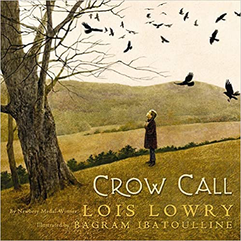
Crow Call. Lois Lowry. Illustrated by Bagram Ibatoulline. Scholastic Press, 2009. (2-5) Hope, Joy
Lois Lowry (author of Number the Stars and other poignant chapter books) created this beautiful picture book tale of young Liz getting to know her father again when he comes home from World War II. He is a stranger, but she longs to reconnect. The haunting illustrations show father and daughter sharing a day, eating breakfast at a diner, then walking through the woods to hunt crows. Liz knows the crows eat the crops, but she doesn’t want her dad to kill them either. Beautiful sensitive illustrations bring you right into the woods on that November day.
Lois Lowry (author of Number the Stars and other poignant chapter books) created this beautiful picture book tale of young Liz getting to know her father again when he comes home from World War II. He is a stranger, but she longs to reconnect. The haunting illustrations show father and daughter sharing a day, eating breakfast at a diner, then walking through the woods to hunt crows. Liz knows the crows eat the crops, but she doesn’t want her dad to kill them either. Beautiful sensitive illustrations bring you right into the woods on that November day.
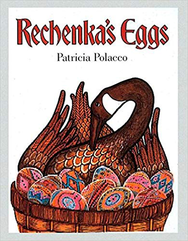
Rechenka’s Eggs. Patricia Polacco.
Puffin, 1996. (2-4) Hope & Joy
Poor Russian peasant woman aids and cares for a wounded goose, undergoes trials as result, but is richly rewarded in the end. A tale of hope, rebirth, and miracles as well as compassion.
Puffin, 1996. (2-4) Hope & Joy
Poor Russian peasant woman aids and cares for a wounded goose, undergoes trials as result, but is richly rewarded in the end. A tale of hope, rebirth, and miracles as well as compassion.
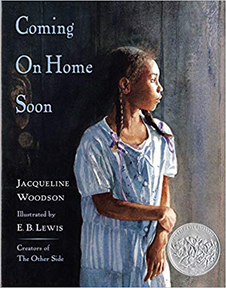
Coming On Home Soon. Jacqueline Woodson.
Illustrated by E. B. Lewis. G.P.Putnam’s Sons, 2004 (2-5) Patience, Hope
Set in the mid-west during World War II, this is a touching tale of an African-American family struggling to survive. With Dad at war, Ada Ruth's Mama must support the family, and finds work in Chicago in one of the many railroad jobs vacated by men. Promising to send money home, she leaves Ada Ruth and her grandmother, who pass the time together, writing letters, telling stories, and waiting for a letter in return. Winter passes slowly, with a bit of joy when a kitten shows up at the door. E. B. Lewis’ gorgeous water colors invite you to sit and wait with Grandma and Ada Ruth and hope that Mama is coming on home soon. (Spoiler: she does!) A wonderful model of hope and patience in a time of trial.
Illustrated by E. B. Lewis. G.P.Putnam’s Sons, 2004 (2-5) Patience, Hope
Set in the mid-west during World War II, this is a touching tale of an African-American family struggling to survive. With Dad at war, Ada Ruth's Mama must support the family, and finds work in Chicago in one of the many railroad jobs vacated by men. Promising to send money home, she leaves Ada Ruth and her grandmother, who pass the time together, writing letters, telling stories, and waiting for a letter in return. Winter passes slowly, with a bit of joy when a kitten shows up at the door. E. B. Lewis’ gorgeous water colors invite you to sit and wait with Grandma and Ada Ruth and hope that Mama is coming on home soon. (Spoiler: she does!) A wonderful model of hope and patience in a time of trial.
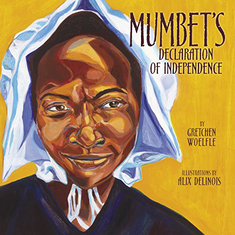
Mumbet’s Declaration of Independence.* Gretchen Woelfle. Illustrated by Alix Delinois. Carolrhoda Books, 2014 (1-4) Hope, Perseverance
Mumbet grows up as a slave to the Ashley family of Massachusetts in the late eighteenth century. She did not mind hard work, but she did mind not being free. One night at a town hall meeting, Mumbet hears people discussing the Constitution for the state, which proclaims that “all men are born equal and free." She takes this to heart and hires a lawyer to sue for her freedom. She is not only successful winning her freedom, but also having slavery declared unconstitutional in Massachusetts! Powerful, bright acrylic illustrations highlight Mumbet’s strength and hope in justice in her future. *Available on Epic!
Mumbet grows up as a slave to the Ashley family of Massachusetts in the late eighteenth century. She did not mind hard work, but she did mind not being free. One night at a town hall meeting, Mumbet hears people discussing the Constitution for the state, which proclaims that “all men are born equal and free." She takes this to heart and hires a lawyer to sue for her freedom. She is not only successful winning her freedom, but also having slavery declared unconstitutional in Massachusetts! Powerful, bright acrylic illustrations highlight Mumbet’s strength and hope in justice in her future. *Available on Epic!
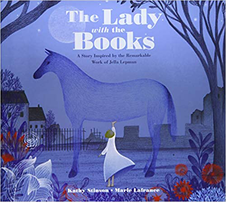
The Lady With the Books* Kathy Stinson. Illustrated by Marie Lafrance. Kids Can Press, 2020. (2-4) Hope, Courage *Available on Epic!
In the wake of World War II, two German children suffer from hunger and see nothing but devastation around them. When they see a long line of people outside a building, they assume the line is for food and quickly join. Instead, they wander into a beautiful exhibit of children's books. Based on a true story, this is the tale of Jella Lepman, a German Jew who escaped Germany before WWII. She returned to her devastated homeland and dedicated herself to helping children who had been traumatized by the war, and her approach was novel: a traveling exhibition of children's books. Children could come to her pavilion and read or be read to -- everything from Winnie the Pooh to Babar to Ferdinand the Bull or Heidi. Lepman knew the children needed books--a world of imagination and hope--as well as food. Attempting to create “bridges of understanding,” she brought back books that had been banned. Anneliese and Pieter forget their hunger for a time and begin to imagine a future.
In the wake of World War II, two German children suffer from hunger and see nothing but devastation around them. When they see a long line of people outside a building, they assume the line is for food and quickly join. Instead, they wander into a beautiful exhibit of children's books. Based on a true story, this is the tale of Jella Lepman, a German Jew who escaped Germany before WWII. She returned to her devastated homeland and dedicated herself to helping children who had been traumatized by the war, and her approach was novel: a traveling exhibition of children's books. Children could come to her pavilion and read or be read to -- everything from Winnie the Pooh to Babar to Ferdinand the Bull or Heidi. Lepman knew the children needed books--a world of imagination and hope--as well as food. Attempting to create “bridges of understanding,” she brought back books that had been banned. Anneliese and Pieter forget their hunger for a time and begin to imagine a future.
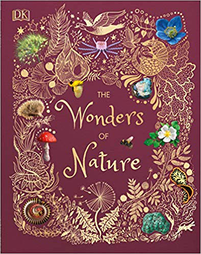
Wonders of Nature. Ben Hoare. Illustrated by Angela Rizza and Daniel Long. DK Children, 2019. Wonder (2-4)
Astonishing illustrations on every page of the 224 pg book! Covering Rocks, Microscopic Life, Plants, and Animals, each page is a delightful bite sized bit of information about so many of natures marvels. It fills you with wonder and leaves you wanting more. This is a treasury that every home and library should have on hand.
Astonishing illustrations on every page of the 224 pg book! Covering Rocks, Microscopic Life, Plants, and Animals, each page is a delightful bite sized bit of information about so many of natures marvels. It fills you with wonder and leaves you wanting more. This is a treasury that every home and library should have on hand.
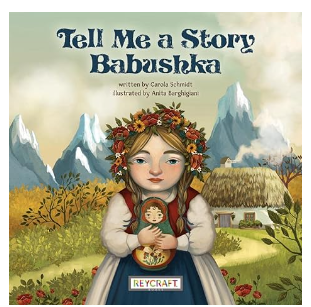
Tell Me A Story, Babushka. Carola Schmidt. Illustrated by Anita Barghigiani. Raycraft Books, 2022. Hope, Courage (2-5)
A granddaughter asks her "Baba" to tell her a story with a princess and a monster. What follows is an unusual and haunting tale of a little princess (the child's grandmother) whose Ukrainian family was taken prisoner by the Soviets and sent to Siberia in the 1930s. The troops that deprive the family of their liberty are depicted as the monsters they were. In a time of fear, the "princess" finds a message in a nesting doll that results in hope and deliverance. The overwhelming theme is light in the darkness, but because this contains dark material based on a factual event, this is for older elementary students. (Set in the "Holodomor" in 1932-33, which was an intentionally caused famine in Ukraine orchestrated by the Soviets.)
A granddaughter asks her "Baba" to tell her a story with a princess and a monster. What follows is an unusual and haunting tale of a little princess (the child's grandmother) whose Ukrainian family was taken prisoner by the Soviets and sent to Siberia in the 1930s. The troops that deprive the family of their liberty are depicted as the monsters they were. In a time of fear, the "princess" finds a message in a nesting doll that results in hope and deliverance. The overwhelming theme is light in the darkness, but because this contains dark material based on a factual event, this is for older elementary students. (Set in the "Holodomor" in 1932-33, which was an intentionally caused famine in Ukraine orchestrated by the Soviets.)

Balloons Over Broadway: The True Story of the Puppeteer of Macy's Parade. Melissa Sweet. Clarion Books, 2011. (2-6) Imagination, Immigrant Heritage Month. How did we get the Macy’s Thanksgiving Day Parade with its iconic giant balloons? Tony Sarg, a German immigrant to the United States came from a family of puppeteers and loved inventing things—from a mechanism to feed his family’s chickens to an eye-catching assortment of marionette displays in Macy’s windows in New York City. When his employer Macy’s wanted to put together a big parade for Thanksgiving, Tony was thrilled. But how could the puppets be big enough to be seen by the huge crowds of 1920s New York? He hatches an imaginative plan—upside-down balloon marionettes. Collage-style illustrations add to the imaginative feel of this book. This could be read to younger children, but older elementary students will appreciate it too.

The Tree of Life: How a Holocaust Sapling Inspired the World. Elisa Boxer. Illustrated by Alianna Rozentsveig. (3-6) Hope, Stewardship, Schools of Faith
The story of young Jewish children and their teacher who smuggled a sapling into their concentration camp in the Czech Republic in celebration of a Jewish holiday, sharing their precious water to allow it to grow. By the time the children were freed, the tree was five feet tall, and when people visited the concentration camp at Terezin to remember its history, they saw a huge, 60-foot tree there. The tree was overcome by a flood in 2007, but 600 saplings from the tree are now around the world—including the Museum of Jewish History in New York City—symbolizing hope for growth out of tragedy.
The story of young Jewish children and their teacher who smuggled a sapling into their concentration camp in the Czech Republic in celebration of a Jewish holiday, sharing their precious water to allow it to grow. By the time the children were freed, the tree was five feet tall, and when people visited the concentration camp at Terezin to remember its history, they saw a huge, 60-foot tree there. The tree was overcome by a flood in 2007, but 600 saplings from the tree are now around the world—including the Museum of Jewish History in New York City—symbolizing hope for growth out of tragedy.
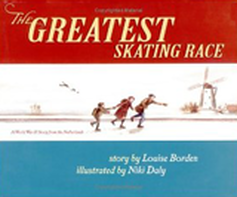
The Greatest Skating Race: A World War II Story from the Netherlands.
Louise Borden. Illustrated by Niki Daly. Margaret K. McElderry Books, 2004. (3-6) Courage, Hope
Ten year-old Piet, a strong skater, dreams of taking first place in his nation's famous two hundred kilometer ice-skating race. But in the winter of 1941, he realizes the most important race in his life may be a mere twelve kilometers long. His grandfather asks him to skate two children (whose lives are in danger in German-occupied Holland) to the safety of the Belgian border. They plot a route and strategy to outwit German guards posted along the frozen canal. Piet must rely not only on his own skating abilities, but on his ability to support and inspire his younger charges to push on with him. A touching and breathtaking work of historical fiction showing that courage starts young and is buttressed by hope.
Louise Borden. Illustrated by Niki Daly. Margaret K. McElderry Books, 2004. (3-6) Courage, Hope
Ten year-old Piet, a strong skater, dreams of taking first place in his nation's famous two hundred kilometer ice-skating race. But in the winter of 1941, he realizes the most important race in his life may be a mere twelve kilometers long. His grandfather asks him to skate two children (whose lives are in danger in German-occupied Holland) to the safety of the Belgian border. They plot a route and strategy to outwit German guards posted along the frozen canal. Piet must rely not only on his own skating abilities, but on his ability to support and inspire his younger charges to push on with him. A touching and breathtaking work of historical fiction showing that courage starts young and is buttressed by hope.
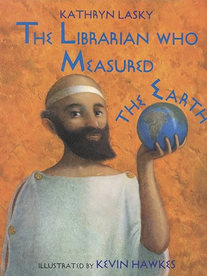
The Librarian Who Measured the Earth. Kathryn Lasky. Illustrated by Kevin Hawkes. Little, Brown Books, 2008. (3-6) Diligence, Imagination, Wonder.
The story of Eratosthenes, a librarian at the Library of Alexandria in the second-century BC. Using mathematical methods explained clearly in the book, Eratosthenes calculated the circumference of the earth—to a figure that we now know was within 200 miles of correct! With vivid illustrations, the book presents Eratosthenes as a model of wonder and imagination, as well as hard intellectual work to achieve a goal.
The story of Eratosthenes, a librarian at the Library of Alexandria in the second-century BC. Using mathematical methods explained clearly in the book, Eratosthenes calculated the circumference of the earth—to a figure that we now know was within 200 miles of correct! With vivid illustrations, the book presents Eratosthenes as a model of wonder and imagination, as well as hard intellectual work to achieve a goal.
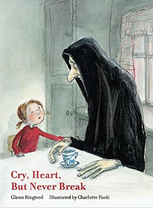
Cry, Heart, But Never Break. Glenn Ringtved. Illustrated by Charlotte Pardi. Trans. by Robert Moulthrop. Enchanted Lion Books, 2016. (2-6) Hope, Courage
Teachers, be sure to read this book before you read it to your class. You'll need to get past your own tears to pull this off. A hauntingly beautiful story of loss, grief, and hope. Danish author Ringtved tells the tale of four children who have been raised by their grandmother. One day she has a dreaded visitor, Death. But black-clad Death, leaves his scythe at the door and enters to teach the children some great truths before he takes their grandmother. Through stories he shows that joy requires sorrow to be meaningful; that sadness needs delight; and that life is meaningful because of death. The children learn consolation and hope in the face of dire loss. A profoundly moving book for children faced with the loss of family members, and because of its depth, appropriate even for older children.
Teachers, be sure to read this book before you read it to your class. You'll need to get past your own tears to pull this off. A hauntingly beautiful story of loss, grief, and hope. Danish author Ringtved tells the tale of four children who have been raised by their grandmother. One day she has a dreaded visitor, Death. But black-clad Death, leaves his scythe at the door and enters to teach the children some great truths before he takes their grandmother. Through stories he shows that joy requires sorrow to be meaningful; that sadness needs delight; and that life is meaningful because of death. The children learn consolation and hope in the face of dire loss. A profoundly moving book for children faced with the loss of family members, and because of its depth, appropriate even for older children.
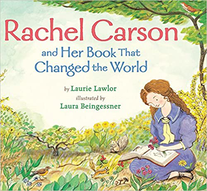
Rachel Carson and Her Book that Changed the World. Laurie Lawlor. Illustrated by Laura Beingessner. Holiday House, 2014. Wonder, Diligence, Stewardship (2-6)
This is a fine introductory biography to a pioneer in environmental science and the author of Silent Spring. As a child exploring Pennsylvania woods, Rachel learned to recognize the call of a yellowthroat and the song of a wood thrush. The family farm constantly fed her curiosity and both parents knew how important education was, sacrificing much to send Rachel to college, where she studied biology. But hard times of the Depression followed and after graduating, Rachel considered herself fortunate to find a job writing for a radio program about sea life. This led to articles for scientific journals, however, and soon her research became well known. She loved writing about nature."Once you are aware of the wonder and beauty of the earth, you will want to learn about it."
This is a fine introductory biography to a pioneer in environmental science and the author of Silent Spring. As a child exploring Pennsylvania woods, Rachel learned to recognize the call of a yellowthroat and the song of a wood thrush. The family farm constantly fed her curiosity and both parents knew how important education was, sacrificing much to send Rachel to college, where she studied biology. But hard times of the Depression followed and after graduating, Rachel considered herself fortunate to find a job writing for a radio program about sea life. This led to articles for scientific journals, however, and soon her research became well known. She loved writing about nature."Once you are aware of the wonder and beauty of the earth, you will want to learn about it."
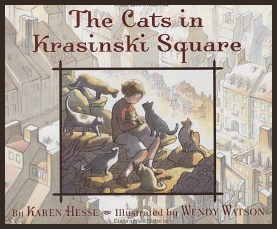
The Cats in Krasinski Square. Karen Hesse.
Illustrated by Wendy Watson. Scholastic, 2004. (3-6)
Courage, Hope
Based on a true story of the Warsaw ghetto, this World War II-era tale is appropriate for older children (third graders and up). A young Jewish girl (ten or twelve) helps her older sister smuggle food to fellow Jews trapped behind the wall of Poland's Warsaw ghetto. The two come up with an ingenious plan to outwit the Gestapo and its dogs (which sniff out food) by using the superabundance of stray cats in Krasinski Square. The clever rouse was the courageous work of a young girl, and it worked. Sparse, lyrical text and uncluttered watercolor illustrations make this a powerful and quick read-aloud for 3-6.
Illustrated by Wendy Watson. Scholastic, 2004. (3-6)
Courage, Hope
Based on a true story of the Warsaw ghetto, this World War II-era tale is appropriate for older children (third graders and up). A young Jewish girl (ten or twelve) helps her older sister smuggle food to fellow Jews trapped behind the wall of Poland's Warsaw ghetto. The two come up with an ingenious plan to outwit the Gestapo and its dogs (which sniff out food) by using the superabundance of stray cats in Krasinski Square. The clever rouse was the courageous work of a young girl, and it worked. Sparse, lyrical text and uncluttered watercolor illustrations make this a powerful and quick read-aloud for 3-6.
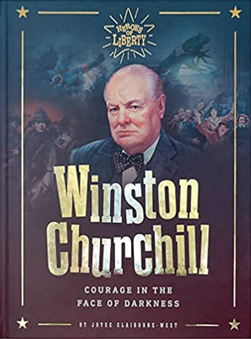
Winston Churchill: Courage in the Face of Darkness. By Joyce Claiborne-West. Illustrated by Stoilov Boris. Heroes of Liberty, 2022. (3-6) Lives to Learn From, Courage
It was the summer of 1940, and things looked dark. It seemed that there was nothing for the British nation to do but surrender to Nazism. But one voice rose up in defiance: Winston Churchill's. A book for older children on the great statesman's hope and, as the subtitle puts it, "courage in the face of darkness."
It was the summer of 1940, and things looked dark. It seemed that there was nothing for the British nation to do but surrender to Nazism. But one voice rose up in defiance: Winston Churchill's. A book for older children on the great statesman's hope and, as the subtitle puts it, "courage in the face of darkness."
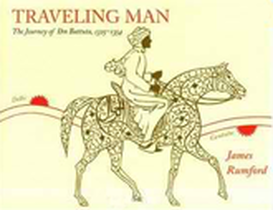
Traveling Man. The Journey of Ibn Batutta, 1325-1354.
James Rumford. Houghton Mifflin, 2001. (3-6) Wonder, Hope
Less well known than Marco Polo, the fourteenth century Moroccan-born traveler Ibn Batutta undertook equally exciting and perilous journeys. He spent nearly three decades traveling the world, leaving a rich account, which is brought to life in this eloquent and elegant picture book. The book inspires not just wonder for the vast world and its unknown marvels, but for the whole experience of travel. While the text is simple, the material is rich and the thoughts run deep. (“Traveling – it gives you a home in a thousand strange places, then leaves you a stranger in your own land.”) This book is a wonderful complement to any study of the late Middle Ages. Profitably read by fourth and fifth graders who may know more of the geography. A fine map at the end shows his journeys through Africa, Arabia, Asia Minor, Russia, India, and China.
James Rumford. Houghton Mifflin, 2001. (3-6) Wonder, Hope
Less well known than Marco Polo, the fourteenth century Moroccan-born traveler Ibn Batutta undertook equally exciting and perilous journeys. He spent nearly three decades traveling the world, leaving a rich account, which is brought to life in this eloquent and elegant picture book. The book inspires not just wonder for the vast world and its unknown marvels, but for the whole experience of travel. While the text is simple, the material is rich and the thoughts run deep. (“Traveling – it gives you a home in a thousand strange places, then leaves you a stranger in your own land.”) This book is a wonderful complement to any study of the late Middle Ages. Profitably read by fourth and fifth graders who may know more of the geography. A fine map at the end shows his journeys through Africa, Arabia, Asia Minor, Russia, India, and China.
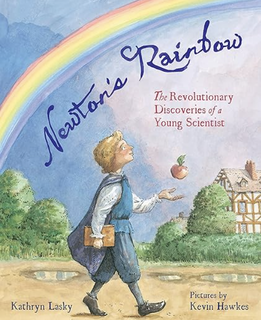
Newton's Rainbow: The Revolutionary Discoveries of a Young Scientist. Kathryn Lasky. Illustrated by Kevin Hawkes. Farrar, Straus and Giroux, 2017. (3-6) Diligence, Imagination, Wonder.
Kathryn Lasky brings her eye for historical detail and her narrative talents to the story of young Isaac Newton, who would eventually discover the law of gravity. A quiet child with a keen intellect, this book emphasizes young Newton's curiosity about the world around him, and the many scientific discoveries—including how rainbows work!—that arose from his curiosity and hard work. Some details about the bubonic plague, and text-heavy explanations of Newton's discoveries, make this book more suited for older readers.
Kathryn Lasky brings her eye for historical detail and her narrative talents to the story of young Isaac Newton, who would eventually discover the law of gravity. A quiet child with a keen intellect, this book emphasizes young Newton's curiosity about the world around him, and the many scientific discoveries—including how rainbows work!—that arose from his curiosity and hard work. Some details about the bubonic plague, and text-heavy explanations of Newton's discoveries, make this book more suited for older readers.
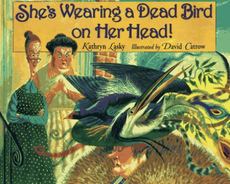
She's Wearing a Dead Bird on Her Head!. Kathryn Lasky. Illustrated by David Catrow. Disney-Hyperion, 1995. (3-6) Responsibility, Wonder, Stewardship, Lives to Learn From.
A fictionalized account of the two founders of the Massachusetts Audobon Society, Harriet Lawrence Hemenway and Minna B. Hall. In the 1890s Hemenway and Hall were society ladies, but were outraged when a new fashion emerged: wearing dead birds on hats. Their campaign to point out that this was ridiculous and cruel is vividly illustrated in this account, based on historical fact but with a note from the author to separate fact from fiction. Out of print, but accessible from libraries or secondary market.
A fictionalized account of the two founders of the Massachusetts Audobon Society, Harriet Lawrence Hemenway and Minna B. Hall. In the 1890s Hemenway and Hall were society ladies, but were outraged when a new fashion emerged: wearing dead birds on hats. Their campaign to point out that this was ridiculous and cruel is vividly illustrated in this account, based on historical fact but with a note from the author to separate fact from fiction. Out of print, but accessible from libraries or secondary market.
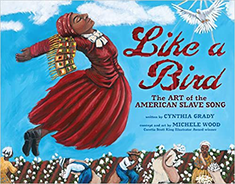
Like a Bird. The Art of the Slave Song. * Cynthia Grady.
Illustrated by Michele Wood. Milbrook Press, 2016 (3-6)
Black History Month, Hope, Faith
Music lends beauty even to our suffering and brings hope. Here the music, lyrics, and history of thirteen Negro Spirituals are compellingly presented and illustrated. Go Down Moses, Swing Low Sweet Chariot, Michael, Row the Boat Ashore, Nobody Knows the Trouble I've Seen are some of the many revisited and explained. Though you may be familiar with some or all of these works sung by slaves in captivity, the explanations of their history and meaning along with the lively folk-art paintings bring new life to this folk art. *Available on Epic!
Illustrated by Michele Wood. Milbrook Press, 2016 (3-6)
Black History Month, Hope, Faith
Music lends beauty even to our suffering and brings hope. Here the music, lyrics, and history of thirteen Negro Spirituals are compellingly presented and illustrated. Go Down Moses, Swing Low Sweet Chariot, Michael, Row the Boat Ashore, Nobody Knows the Trouble I've Seen are some of the many revisited and explained. Though you may be familiar with some or all of these works sung by slaves in captivity, the explanations of their history and meaning along with the lively folk-art paintings bring new life to this folk art. *Available on Epic!
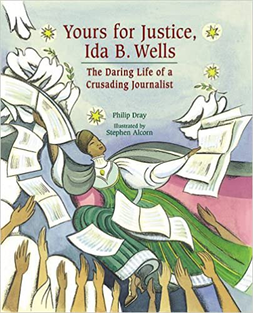
Yours For Justice, Ida B. Wells. The Daring Life of a Crusading Journalist* Philip Dray. Illustrated by Stephen Alcorn. Peachtree Publishing, 2008 (3-6) Justice, Hope, Compassion, Lives to Learn From
Born into slavery but freed by the Emancipation Proclamation, Ida B. Wells was a force of nature. She loved to read, and reading the newspaper to her father opened her eyes to the world beyond her small town. When she lost both her parents and her brother to an epidemic, she took charge of her six siblings and taught school to support them. She never stopped learning, and she felt the need to start writing about the injustices daily. She became a leading journalist, writing about many issues, but when one of her friends was lynched, Ida became the voice for justice for him and many others like him. Intriguing illustrations bring Ida’s story to life. Afterword and bibliography make this a great tribute to a Life to Learn From. *Available on Epic!
Born into slavery but freed by the Emancipation Proclamation, Ida B. Wells was a force of nature. She loved to read, and reading the newspaper to her father opened her eyes to the world beyond her small town. When she lost both her parents and her brother to an epidemic, she took charge of her six siblings and taught school to support them. She never stopped learning, and she felt the need to start writing about the injustices daily. She became a leading journalist, writing about many issues, but when one of her friends was lynched, Ida became the voice for justice for him and many others like him. Intriguing illustrations bring Ida’s story to life. Afterword and bibliography make this a great tribute to a Life to Learn From. *Available on Epic!

Marco Polo. Demi.
Two Lions Publishing, 2012 (3-6) Wonder
Demi’s lush, intricate illustrations immerse young readers in “a seamless tale of wonder,” as Barbara Auerbach described it. In 1254 the young Venetian, Marco Polo, embarked on a world journey that led him to China, Persia, the Holy Land, India, Arabia, Egypt, and then home. Twenty-four years and thirty-three thousand miles later, Polo had served as an advisor to China’s Kublai Khan; an ambassador for him abroad, and an explorer par excellence. Marco Polo survived deserts, monsoons, and dust storms; climbed mountains and battled bandits, pirates and cannibals. He was open to and awed by what he encountered, and he lived to tell his tales back home. Whether he exaggerated has always been a matter of dispute, but this rendering, with Demi’s exquisite illustrations, captures his own quest for knowledge and wonder before the unexplained.
Two Lions Publishing, 2012 (3-6) Wonder
Demi’s lush, intricate illustrations immerse young readers in “a seamless tale of wonder,” as Barbara Auerbach described it. In 1254 the young Venetian, Marco Polo, embarked on a world journey that led him to China, Persia, the Holy Land, India, Arabia, Egypt, and then home. Twenty-four years and thirty-three thousand miles later, Polo had served as an advisor to China’s Kublai Khan; an ambassador for him abroad, and an explorer par excellence. Marco Polo survived deserts, monsoons, and dust storms; climbed mountains and battled bandits, pirates and cannibals. He was open to and awed by what he encountered, and he lived to tell his tales back home. Whether he exaggerated has always been a matter of dispute, but this rendering, with Demi’s exquisite illustrations, captures his own quest for knowledge and wonder before the unexplained.
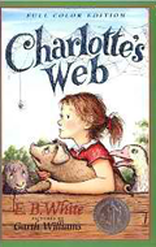
Charlotte’s Web. E.B. White.
Illustrated by Garth Williams and Rosemary Wells. Harper Collins, 2012. 192 pgs.(3-6) Hope, Wonder
Beloved by generations, Charlotte’s Web is the story of a runt-of-the-litter pig named Wilbur, adopted by a farm girl named Fern, and befriended by a spider named Charlotte. In this magical barn kingdom, Wilbur can talk to both Fern and all the farm animals. When Fern learns that her adorable pet pig is to be fattened for someone’s dinner, she is devastated, but Wilbur even more so. Charlotte, the wise, enterprising and resourceful spider, weaves a pattern in her web that ensures his survival. The pure joy, delight, and wonder of this book, with its extraordinary characters and very right ending have made it a classic for generations.
Illustrated by Garth Williams and Rosemary Wells. Harper Collins, 2012. 192 pgs.(3-6) Hope, Wonder
Beloved by generations, Charlotte’s Web is the story of a runt-of-the-litter pig named Wilbur, adopted by a farm girl named Fern, and befriended by a spider named Charlotte. In this magical barn kingdom, Wilbur can talk to both Fern and all the farm animals. When Fern learns that her adorable pet pig is to be fattened for someone’s dinner, she is devastated, but Wilbur even more so. Charlotte, the wise, enterprising and resourceful spider, weaves a pattern in her web that ensures his survival. The pure joy, delight, and wonder of this book, with its extraordinary characters and very right ending have made it a classic for generations.

The Day-Glo Brothers: The True Story of Bob and Joe Switzer’s Bright Ideas and Brand-New Colors. Chris Barton. Illustrated by Tony Persiani. Charlesbridge, 2009. (3-6) Imagination, Wonder.
Two inventive brothers are full of new ideas—flying planes, inventing a device to make their pharmacist father’s life easier, doing new and stunning magic tricks. When one brother is injured and recovering in the basement, the bored brothers decide to try out something they read about in Popular Mechanics: ultraviolet light. Lots of experimenting later, they’ve found a way to make paint glow. Whimsical illustrations in black and white give way gradually to more and more colorful illustrations in Day-Glo colors that will glow under a black light—a delightful trick that will help a wordy book engage younger kids too.
Two inventive brothers are full of new ideas—flying planes, inventing a device to make their pharmacist father’s life easier, doing new and stunning magic tricks. When one brother is injured and recovering in the basement, the bored brothers decide to try out something they read about in Popular Mechanics: ultraviolet light. Lots of experimenting later, they’ve found a way to make paint glow. Whimsical illustrations in black and white give way gradually to more and more colorful illustrations in Day-Glo colors that will glow under a black light—a delightful trick that will help a wordy book engage younger kids too.

Just Like Rube Goldberg: The Incredible True Story of the Man Behind the Machines. Sarah Aronson. Illustrated by Robert Neubecker. Beach Lane Books, 2019. (3-6) Imagination, Diligence.
Lively, detailed, cartoon-like illustrations illuminate the remarkable life of Rube (pronounced "Roob") Goldberg, who dreams of being a great cartoonist. His father, an immigrant from Germany, forbids him from pursuing such an uncertain career, so Rube gets a degree in engineering in the early 1900s and starts work. But eventually he ends up living his dream: working as a cartoonist for the San Francisco Chronicle, and then in New York City, where his iconic cartoons are a huge hit with audiences. His character, Professor Lucifer Gorgonzola Butts, the inventor of impossibly elaborate machines to accomplish simple tasks, puts Goldberg on the map. Aspiring engineers, inventors, and artists alike will enjoy this fanciful story, and it might inspire kids to build Rube Goldberg machines of their own! And kids will learn a new adjective: in the sentence "on the table was a Rube Goldberg arrangement of flasks and test tubes," "Rube Goldberg" means a "fantastically complicated, improvised appearance."
Lively, detailed, cartoon-like illustrations illuminate the remarkable life of Rube (pronounced "Roob") Goldberg, who dreams of being a great cartoonist. His father, an immigrant from Germany, forbids him from pursuing such an uncertain career, so Rube gets a degree in engineering in the early 1900s and starts work. But eventually he ends up living his dream: working as a cartoonist for the San Francisco Chronicle, and then in New York City, where his iconic cartoons are a huge hit with audiences. His character, Professor Lucifer Gorgonzola Butts, the inventor of impossibly elaborate machines to accomplish simple tasks, puts Goldberg on the map. Aspiring engineers, inventors, and artists alike will enjoy this fanciful story, and it might inspire kids to build Rube Goldberg machines of their own! And kids will learn a new adjective: in the sentence "on the table was a Rube Goldberg arrangement of flasks and test tubes," "Rube Goldberg" means a "fantastically complicated, improvised appearance."
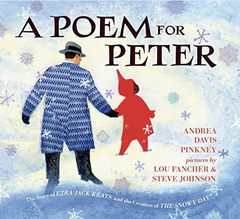
A Poem for Peter. Andrea Davis Pinkney. Illustrated by Steve Johnson.
Viking Books, 2016. (3-6) Wonder, Imagination, Immigrant Heritage Month.
The subtitle says it all: The Story of Ezra Jack Keats and the Creation of the Snowy Day. Delightful illustrations, reminiscent of the [earlier] classic children's book, grace [a] this biography of The Snowy Day’s author, Ezra Jack Keats. Keats himself was the son of Polish immigrants and grew up on New York's lower east side, with a heart for art and for the underdog. When he saw a photo of an African-American child in the snow (the great equalizing blanket), his heart was moved and the book, one of the first to feature a child of color (Peter), was born. The text, written in verse, is thought-provoking and
tells the story in a unique way.
Viking Books, 2016. (3-6) Wonder, Imagination, Immigrant Heritage Month.
The subtitle says it all: The Story of Ezra Jack Keats and the Creation of the Snowy Day. Delightful illustrations, reminiscent of the [earlier] classic children's book, grace [a] this biography of The Snowy Day’s author, Ezra Jack Keats. Keats himself was the son of Polish immigrants and grew up on New York's lower east side, with a heart for art and for the underdog. When he saw a photo of an African-American child in the snow (the great equalizing blanket), his heart was moved and the book, one of the first to feature a child of color (Peter), was born. The text, written in verse, is thought-provoking and
tells the story in a unique way.
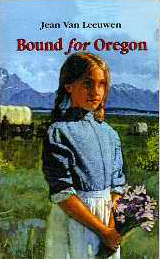
Bound for Oregon. Jean Van Leeuwen.
Puffin, 1996. 164 pgs. (3-6)Hope, Perseverance
This slender historical novel shows the power of hope and determination in one of the most trying adventures of the mid-nineteenth century – the 2000 mile trek across the Oregon Trail. A pioneer’s story told from the vantage point of a nine-year old girl, Mary Ellen Todd. Well researched and hugely reaffirming of the human spirit.
Puffin, 1996. 164 pgs. (3-6)Hope, Perseverance
This slender historical novel shows the power of hope and determination in one of the most trying adventures of the mid-nineteenth century – the 2000 mile trek across the Oregon Trail. A pioneer’s story told from the vantage point of a nine-year old girl, Mary Ellen Todd. Well researched and hugely reaffirming of the human spirit.
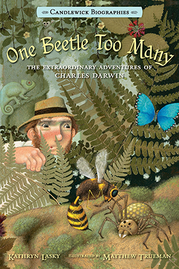
One Beetle Too Many: The Extraordinary Adventures of Charles Darwin. Kathryn Lasky. Illustrated by Matthew Trueman. (Candlewick, 2014) 4-6 Wonder, Imagination, Lives to Learn From
Kathryn Lasky is queen of the older child's picture book and this work is no exception. Lively, illuminating text and striking illustrations bring Charles Darwin to life: his boundless curiosity as a child, fascination with collecting beetles and just about anything, a naturalist by leaning, though an easily bored student. His father disapproved of his professional choices, but Darwin followed his heart when he boarded the S. S. Beagle for the world-changing voyage that rendered the theory of evolution. Lasky's ability to distill complicated concepts into intelligible and conversational language distinguishes her work. The illustrations sing. A great older grade read-aloud.
Kathryn Lasky is queen of the older child's picture book and this work is no exception. Lively, illuminating text and striking illustrations bring Charles Darwin to life: his boundless curiosity as a child, fascination with collecting beetles and just about anything, a naturalist by leaning, though an easily bored student. His father disapproved of his professional choices, but Darwin followed his heart when he boarded the S. S. Beagle for the world-changing voyage that rendered the theory of evolution. Lasky's ability to distill complicated concepts into intelligible and conversational language distinguishes her work. The illustrations sing. A great older grade read-aloud.
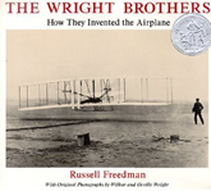
The Wright Brothers: How They Invented the Airplane. Russell Freedman.
Holiday House, 1991 (4-6) Imagination, Perseverance
A superb photo biography of the two brothers whose diligence, perseverance and confidence took us into the age of aviation. Orville and Wilbur Wright excelled in methodically documenting their experiments, learning from failures, photographing their progress, and ultimately in persuading a not-terribly-interested federal government that their “flying machine” might be worth a second look. A wonderful true story of tenacity told with the verve and historical authenticity that Russell Freedman brings to all his work.
Holiday House, 1991 (4-6) Imagination, Perseverance
A superb photo biography of the two brothers whose diligence, perseverance and confidence took us into the age of aviation. Orville and Wilbur Wright excelled in methodically documenting their experiments, learning from failures, photographing their progress, and ultimately in persuading a not-terribly-interested federal government that their “flying machine” might be worth a second look. A wonderful true story of tenacity told with the verve and historical authenticity that Russell Freedman brings to all his work.
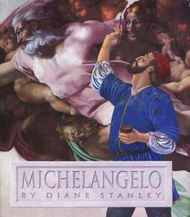
Michelangelo. Diane, Stanley. Harper Collins, 2003. (4-6) Imagination, Diligence, Perseverance Well researched and beautifully illustrated, Stanley has once again distilled “essence.” Her poignant picture book biography of the mercurial and impatient sculptor (turned painter, architect, and poet) shows that a man who was clearly not perfect, could still be “excellent” – which is the root meaning of the world virtue. Michelangelo’s unflinching devotion to his craft comes across clearly, as do his painstaking efforts to find new ways to embody human form and striving in marble and plaster.
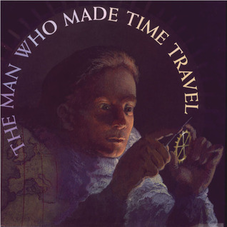
The Man Who Made Time Travel. Kathryn Lasky. Illustrated by Kevin Hawkes. Farrar, Straus and Giroux, 2003. (5-6) Diligence, Lives to Learn From, Imagination
This is a challenging but rewarding science biography for fifth and sixth graders. It is a story of perseverance and extraordinary intellectual virtue. Eighteenth century English clockmaker John Harrison attempted to solve the problem of measuring longitude at sea with a clock that would not lose time. (The relationship of time to longitude is the challenging scientific concept in this book.) Harrison developed the first accurate chronometer, which became an invaluable guide for modern navigators. But the process was painstaking. Driven and determined, Harrison spent his life developing a series of clocks that would ensure maritime safety. He faced great professional skepticism about the clearly proven results of his work. This is a model of clear-eyed scientific inquiry and virtue in action.
This is a challenging but rewarding science biography for fifth and sixth graders. It is a story of perseverance and extraordinary intellectual virtue. Eighteenth century English clockmaker John Harrison attempted to solve the problem of measuring longitude at sea with a clock that would not lose time. (The relationship of time to longitude is the challenging scientific concept in this book.) Harrison developed the first accurate chronometer, which became an invaluable guide for modern navigators. But the process was painstaking. Driven and determined, Harrison spent his life developing a series of clocks that would ensure maritime safety. He faced great professional skepticism about the clearly proven results of his work. This is a model of clear-eyed scientific inquiry and virtue in action.

One Yellow Daffodil: A Hanukkah Story. David Adler.
Harcourt, Brace and Jovanovich, 1995. (4-6) Hope
Profoundly moving story of an elderly Jewish man, who survived the horrors of Auschwitz by clinging to the promise of one daffodil in the death camp. Later in New York, he rediscovers the meaning of hope through Hanukkah and a family who reaches out to him. Not appropriate before 4th grade.
Harcourt, Brace and Jovanovich, 1995. (4-6) Hope
Profoundly moving story of an elderly Jewish man, who survived the horrors of Auschwitz by clinging to the promise of one daffodil in the death camp. Later in New York, he rediscovers the meaning of hope through Hanukkah and a family who reaches out to him. Not appropriate before 4th grade.
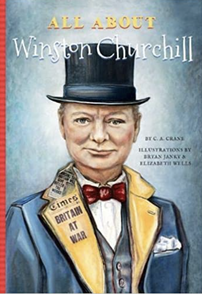
All About Winston Churchill. Cynthia Crane. Blue River Press, 2018. (4-6) Hope, Courage
A book for older children about the life of Winston Churchill, from his early childhood and school days to his work at the helm of Great Britain in World War II. For older readers looking for an illustrated chapter book.
A book for older children about the life of Winston Churchill, from his early childhood and school days to his work at the helm of Great Britain in World War II. For older readers looking for an illustrated chapter book.
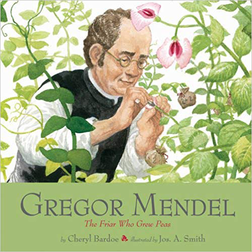
Gregor Mendel. The Friar Who Grew Peas. Cheryl Bardoe.
Illustrated by Jos. A. Smith. Abrams, 2015. (4-6) Wonder, Diligence
This extraordinary picture book presents the compelling life of one who wondered fearlessly. As a child growing up on a farm in (what is now) the Czech republic, Gregor Mendel wondered why two kinds of apple trees grown in proximity produced better fruit than a single type grown alone or why breeding two different kinds of sheep yielded thicker wool. Mendel’s curiosity and wonder propelled him to seek an education despite his family’s poverty, enter religious life where he had access to libraries and scholarship, and then conduct his own meticulous experiments with 28,000 pea plants. Through patient experimentation he discovered certain rules for passing on what he called “dominant” and “recessive” traits. Friar Gregor is now known as the world’s first geneticist, and “Mendel’s laws” (1865) are foundational to the modern science. The Friar’s life provides additional lessons in the virtues of persistence and humility: though he published his work and attempted to disseminate it, fellow scientists ignored him. “Mendel’s laws” lay unnoticed until 1900, when three scientists interested in precisely these questions, happened upon his paper, and the rest is history (or genetics)... Gorgeous illustrations, beautifully told, but because of the science involved, this is an older child’s book.
Illustrated by Jos. A. Smith. Abrams, 2015. (4-6) Wonder, Diligence
This extraordinary picture book presents the compelling life of one who wondered fearlessly. As a child growing up on a farm in (what is now) the Czech republic, Gregor Mendel wondered why two kinds of apple trees grown in proximity produced better fruit than a single type grown alone or why breeding two different kinds of sheep yielded thicker wool. Mendel’s curiosity and wonder propelled him to seek an education despite his family’s poverty, enter religious life where he had access to libraries and scholarship, and then conduct his own meticulous experiments with 28,000 pea plants. Through patient experimentation he discovered certain rules for passing on what he called “dominant” and “recessive” traits. Friar Gregor is now known as the world’s first geneticist, and “Mendel’s laws” (1865) are foundational to the modern science. The Friar’s life provides additional lessons in the virtues of persistence and humility: though he published his work and attempted to disseminate it, fellow scientists ignored him. “Mendel’s laws” lay unnoticed until 1900, when three scientists interested in precisely these questions, happened upon his paper, and the rest is history (or genetics)... Gorgeous illustrations, beautifully told, but because of the science involved, this is an older child’s book.
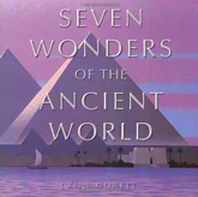
Seven Wonders of the Ancient World. Lynn Curlee.
Atheneum, 2002. (4-6) Imagination, Wonder,
To leave something that will last forever… Art historian Lynn Curlee brings his formidable talents to the world of antiquity and looks at the seven wonders of the ancient world renown for their “size, beauty, grandeur and perfection.” The pyramid at Giza, the Hanging Gardens of Babylon, the Colossus at Rhodes, the Mausoleum at Halicarnassus, and others are explored with an eye toward all that makes us marvel. This work, illustrated by Curlee’s fabulous paintings, excites intellectual curiosity and wonder.
Atheneum, 2002. (4-6) Imagination, Wonder,
To leave something that will last forever… Art historian Lynn Curlee brings his formidable talents to the world of antiquity and looks at the seven wonders of the ancient world renown for their “size, beauty, grandeur and perfection.” The pyramid at Giza, the Hanging Gardens of Babylon, the Colossus at Rhodes, the Mausoleum at Halicarnassus, and others are explored with an eye toward all that makes us marvel. This work, illustrated by Curlee’s fabulous paintings, excites intellectual curiosity and wonder.
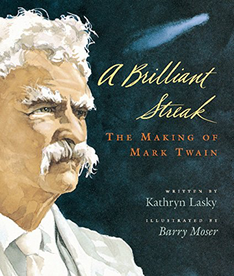
A Brilliant Streak: The Making of Mark Twain. Kathryn Lasky.
Illustrated by Barry Moser. Harcourt Brace, 1998. (5-6)Imagination
With grace and wit Lasky recounts the youth and young adulthood Twain, who was born the night Haley’s Comet streaked across the sky (1835). He didn’t care much for organized religion (when it lost sight of wrongs like slavery) and admitted to being a “truth-stretcher” for the sake of a good story. “I was born excited,” he wrote, and this rich account traces the events that made him a great storyteller with a huge heart.
Illustrated by Barry Moser. Harcourt Brace, 1998. (5-6)Imagination
With grace and wit Lasky recounts the youth and young adulthood Twain, who was born the night Haley’s Comet streaked across the sky (1835). He didn’t care much for organized religion (when it lost sight of wrongs like slavery) and admitted to being a “truth-stretcher” for the sake of a good story. “I was born excited,” he wrote, and this rich account traces the events that made him a great storyteller with a huge heart.
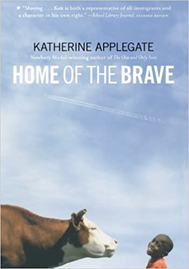
Home of the Brave. Katherine Applegate.
Square Fish, 2008. Hope, Joy, Gratitude, Courage. 5-6
This story is not to be missed: you will laugh, cry, and shout for joy with Kek, a ten-year-old boy who, fleeing violence in his African homeland (Sudan), and has settled (with aunt and cousin) in Minnesota. Kek is an optimist, who earnestly strives to embrace his new life, and is quick to see goodness. In Minnesota, he experiences the joy and hardship of winter (moon-shaped snowballs but bone-chilling cold), of school (a chair and desk of his own, but sometimes classmates who mock him), of technology (machines that wash clothes and dishes, but do not forgive if he puts dishes in the wrong one). He is often overcome with wonder at the "honors" that come to him for free. But he is haunted by the memories of violence that took his father and brother, and the uncertainty of ever seeing his mother again. Is she even alive? Then there is the nagging question of whether America will ever be home for him. His friendships (with Hannah, a girl in foster care and Lou, an older woman who runs a farm) and ingenious schemes to better his life and the lives of those around him will win your heart. (Spoiler alert: Mom is alive and joins him at the end.) It is a book of hope, gratitude, and great courage shown on the part of one so young, as by many immigrants over the years. Though it is 272 pages, it is written in free verse with wide margins. A riveting read-aloud over 5-7 sessions for older children.
Square Fish, 2008. Hope, Joy, Gratitude, Courage. 5-6
This story is not to be missed: you will laugh, cry, and shout for joy with Kek, a ten-year-old boy who, fleeing violence in his African homeland (Sudan), and has settled (with aunt and cousin) in Minnesota. Kek is an optimist, who earnestly strives to embrace his new life, and is quick to see goodness. In Minnesota, he experiences the joy and hardship of winter (moon-shaped snowballs but bone-chilling cold), of school (a chair and desk of his own, but sometimes classmates who mock him), of technology (machines that wash clothes and dishes, but do not forgive if he puts dishes in the wrong one). He is often overcome with wonder at the "honors" that come to him for free. But he is haunted by the memories of violence that took his father and brother, and the uncertainty of ever seeing his mother again. Is she even alive? Then there is the nagging question of whether America will ever be home for him. His friendships (with Hannah, a girl in foster care and Lou, an older woman who runs a farm) and ingenious schemes to better his life and the lives of those around him will win your heart. (Spoiler alert: Mom is alive and joins him at the end.) It is a book of hope, gratitude, and great courage shown on the part of one so young, as by many immigrants over the years. Though it is 272 pages, it is written in free verse with wide margins. A riveting read-aloud over 5-7 sessions for older children.
For an extensive bibliography of quality children's literature exemplifying these virtues,
see the Core Virtues Resource Guide.
Additional suggestions by virtue for K-3 ; Additional suggestions for 3-6
see the Core Virtues Resource Guide.
Additional suggestions by virtue for K-3 ; Additional suggestions for 3-6


